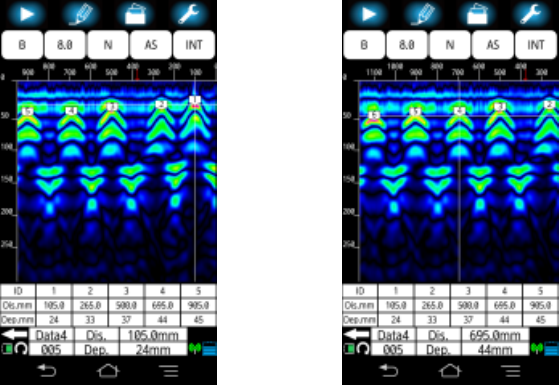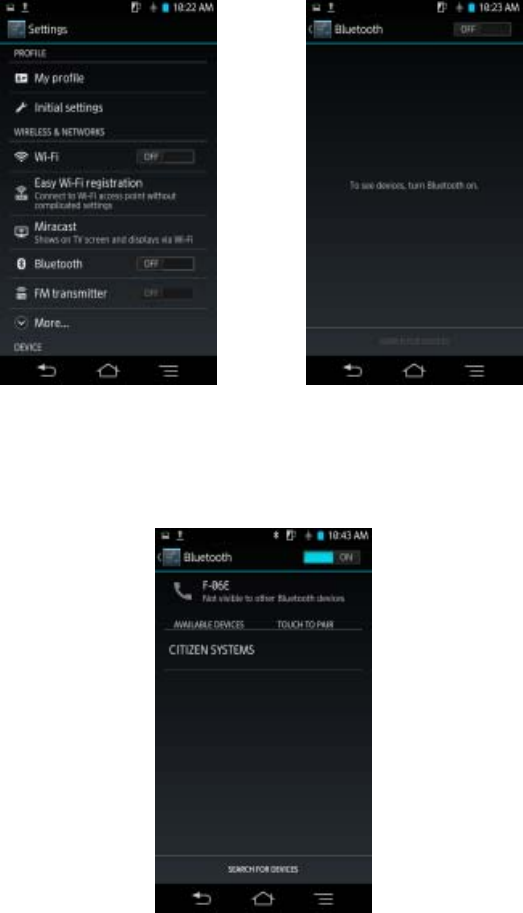Japan Radio NJJ-200 Handy Search User Manual NJJ 95A
Japan Radio Co Ltd. Handy Search NJJ 95A
Contents
- 1. Users Manual 1
- 2. Users Manual 2
- 3. Users Manual 3
- 4. Instruction of testing sample
Users Manual 2
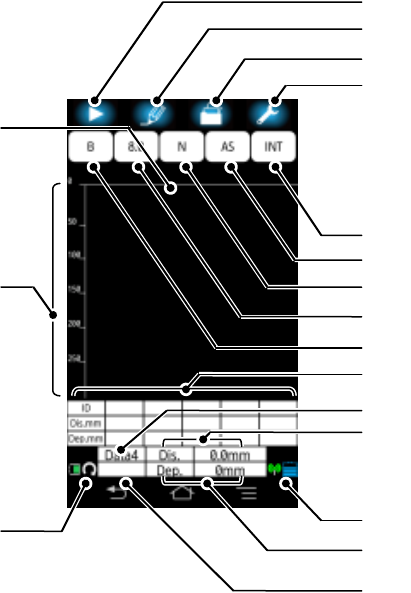
35
4. NJJ-200 application functions
Here is a screen-by-screen description of all functions of NJJ-200 application.
4.1. Main screen
Figure 4-1 shows the name of each part which appears on the main screen of NJJ-2000
application.
Figure 4-1 Main screen of NJJ-200 application
①[Start] icon
②[Mark] icon
③[File/Print] icon
④[Parameter] icon
⑤[Image processing] icon
⑥[Sensitivity] icon
⑦[View range] icon
⑧[Relative permittivity]
icon
⑨[Display mode] icon
⑩Marker list
⑪Folder
⑫Cursor distance
⑬Sensor unit battery capacity
⑭Cursor depth
⑮Data number
⑯Distance scale
⑰Depth scale
⑱Smartphone
battery capacity
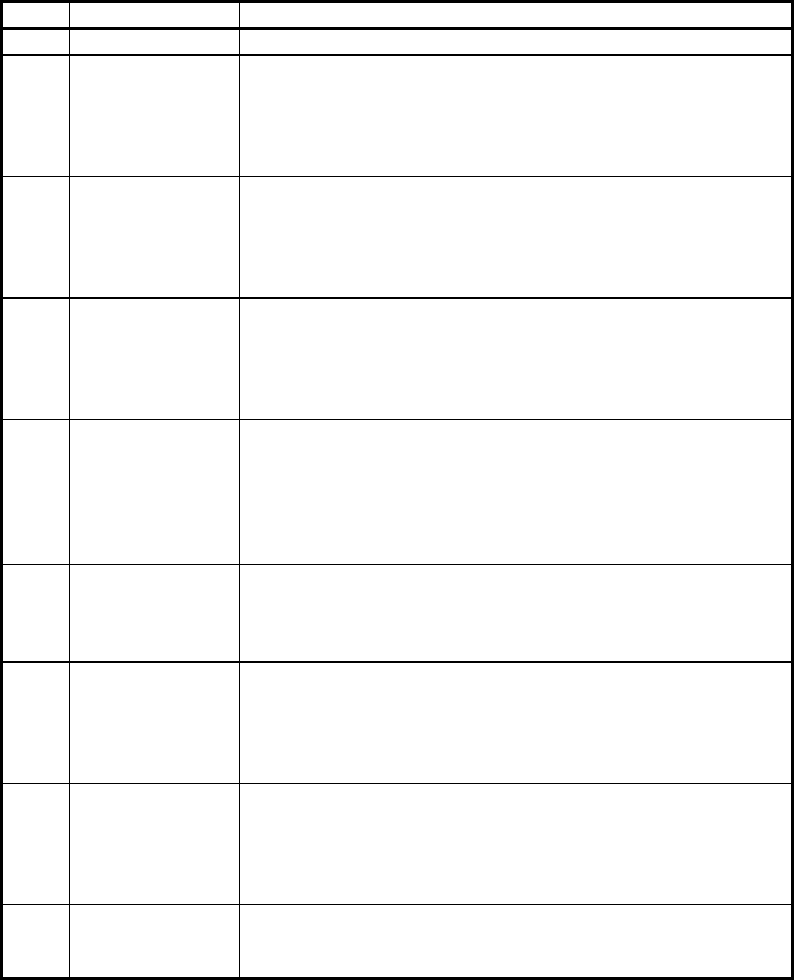
36
Table 4-1 Functions of the main screen (1/2)
Ref
#
Name Function
① [Start] icon Tapping this icon start or stop the scan.
② [Mark] icon
By tapping this icon, you can place an antenna mark or a
marker on the main screen. For this detail, refer to
Section 4.3 [Mark] icon. Also by long tapping this icon you can
access to the marker operation screen. For this detail, refer to
Section 4.13 Marker operation.
③ [File/Print] icon
By tapping this icon, you can save the scan result into a file or
to print out the scan result to the external printer. For this
detail, refer to Section 4.4 [File/Print] icon. Also by long
tapping this icon you can access to the external output setup
screen. For this detail, refer to Section 5 External output.
④ [Parameter]
icon
By tapping this icon, you can set the color and unit displayed
on the main screen. For this details, refer to
Section 4.5 [Parameter] icon. Also by long tapping this icon,
you can access the parameter setup screen. For this details,
refer to Section 4.11 Parameter setup.
⑤
[Image
Processing]
icon
Shows the current setting of the image processing. By
tapping this icon, you can access the image processing
screen. For this detail, refer to Section 4.10 [Image
processing] icon. For the the image processing used during
the scan, refer to Section 4.11.4 Device setting: [Image
processing] menu.
⑥ [Sensitivity]
icon
Shows the current setting of the sensitivity. By tapping this
icon, you can set the sensitivity. For this detail, refer
to 4.9 [Sensitivity] icon. For the sensitivity used during the
san, refer to Section 4.11.2 Device setting: [Sensitivity] menu.
⑦
[View range]
icon
Show the current setting of the view range. By tapping this
icon, you can set the view range. For this detail, refer to
Section 4.8 [View range] icon. For the view range used
during the scan, refer to Section 4.11.3 Device setting: [View
range] menu.
⑧
[Relative
permittivity]
icon
Shows the current setting of the relative permittivity. By
tapping this icon, you can set the relative permittivity. For this
detail, refer to Section 4.7 [Relative permittivity] icon. For the
relative permittivity used during the scan, refer to
Section 4.11.1 Device setting: [Relative permittivity] menu.
⑨ [Display mode]
icon
Shows the current setting of the display mode. By tapping this
icon, you can set the display mode. For this detail, refer to
Section 4.6 [Display mode] icon.
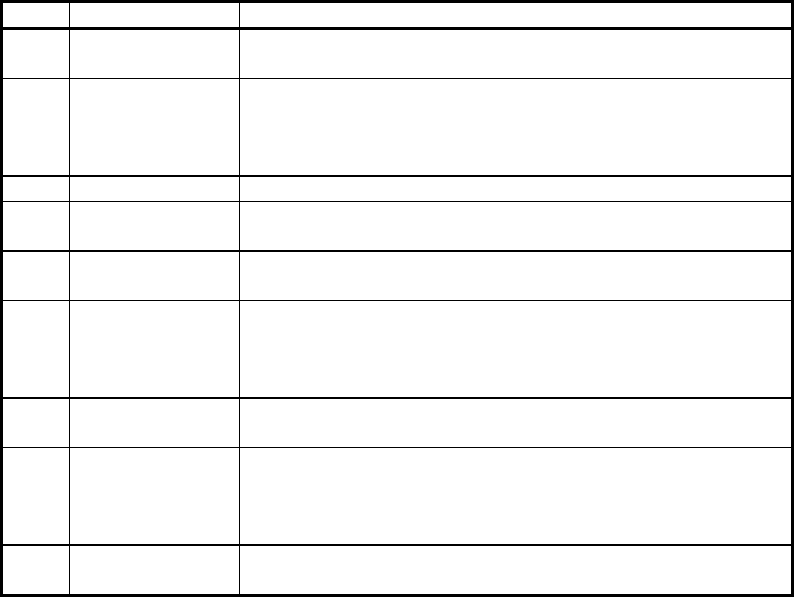
37
Table 4-1 Functions of Main screen (2/2)
Ref
#
Name Function
⑩ Maker list Shows the coordinate of each registered marker. For this
detail, refer to Section 4.3.3 Marker list.
⑪ Folder
Shows the current setting of the folder. The file operation
(saving and recalling) are performed for the file under the
selected folder. For this detail, refer to Section 4.12.3 [Select
Folder] menu.
⑫ Cursor distance Shows the distance coordinate of the cursor.
⑬ Sensor unit
battery capacity
Shows the remained capacity of the sensor unit’s battery
roughly.
⑭ Cursor depth Shows the depth coordinate of the cursor.
⑮ Data number
Shows the current setting of the data number. The scan result
is saved into the file whose name is decided by the data
number. For this detail, refer to Section 4.12.4 [Data number
setting] menu.
⑯ Distance scale Is the moving distance scale. Antenna markers and the line
marker of the image processing are shown on this scale.
⑰ Depth scale
Is the depth scale. This scale changes in accordance with the
depth calibration (relative permittivity setting). For the depth
calibration, refer to Sections 4.7 [Relative permittivity] icon
and 4.11.1 Device setting: [Relative permittivity] menu.
⑱ Smartphone
battery capacity
Shows the remained capacity of Smartphone’s battery
roughly.
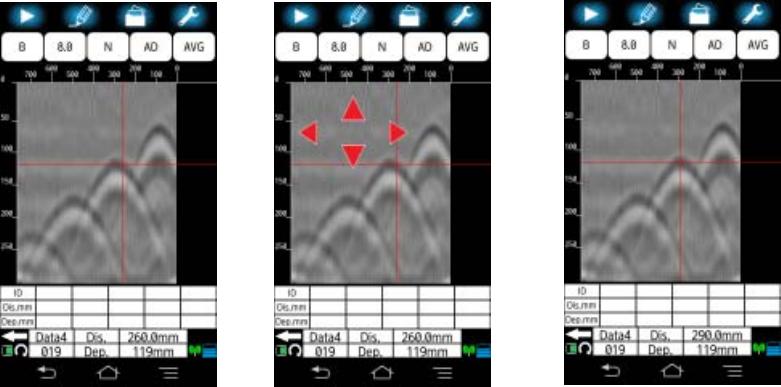
38
4.2. Cursor and scroll
At the idle state (not scanning), by tapping the B mode screen at the desired position, you
can show the cursor at the tapped position. The cursor consists of horizontal and vertical
lines. The coordinate of the cursor (cross point of the horizontal and vertical lines) is shown
at the cursor distance and the cursor depth (Refer to Figure 4-1 ⑫ and ⑭).
By long tapping the B mode screen, you can show the fine tuning arrow on the B mode
screen. Then you can move the cursor exactly on the desired position by tapping the arrow
(up, down, right, or left). After 3 seconds of no operation to the arrow, the arrow disappears
automatically.
The B mode screen can be scrolled by sliding the finger toward right or left direction on the
B mode screen.
1) Cursor 2) Fine tuning arrow 3) After fine tuning
Figure 4-2 Cursor
)
)
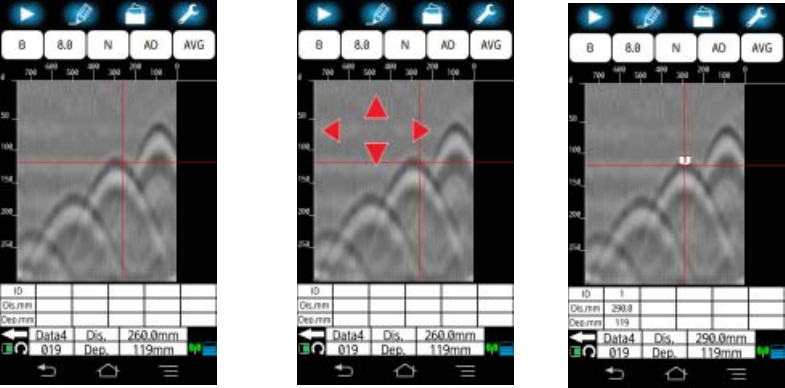
39
4.3. [Mark] icon
At the idle state (not scanning), by tapping [Mark] icon (refer to Figure 4-1 ②), you can
add or delete a marker at the cursor position (cross point of the cursor’s horizontal and
vertical lines).
Added markers can be grouped into three marker groups. You can register maximum 99
markers in one marker group. For the procedure to set the marker group, refer to
Section 4.13.6 [Marker group setting] menu.
4.3.1. Marker addition
You can add a marker with the following procedure.
(1) Tap a position on the B mode screen nearby the position where you want to place a
marker. Then the cursor appears at the tapped position.
(2) Long tap B mode screen anywhere to show fine tuning arrow. Then move the cursor
at the desired position on the B mode screen by tapping the fine tuning arrow.
(3) Tap [Mark] icon. Then you can place a marker at the desired position (cursor
position).
1)Tap B mode screen 2)Long tap B mode screen 3)Tap [Mark] icon
Figure 4-3 Marker addition
)
)
)
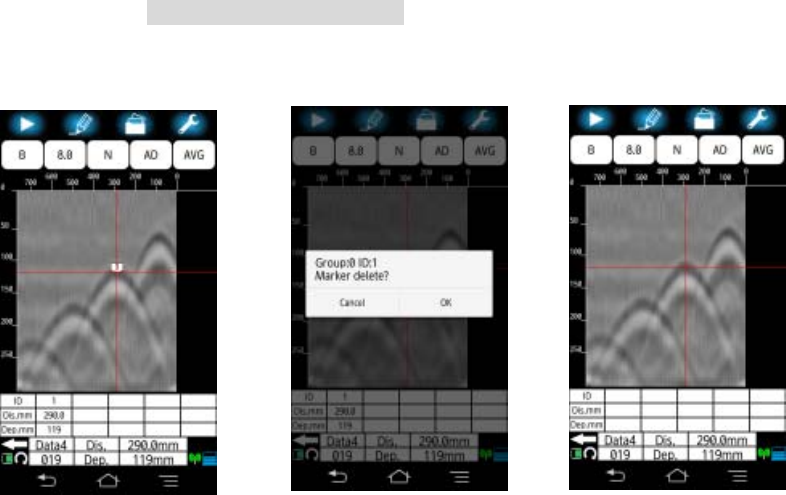
40
4.3.2. Marker deletion
You can delete the selected marker by the following procedure.
(1) Tap the marker to be deleted on the B mode screen or in the marker list. Then the
cursor appears on the tapped marker. Then tap [Mark] icon.
(2) A message “Group:x IDx Marker delete? “ [Cancel] [OK] appears. Tap [OK] to delete
the selected marker. To cancel the marker deletion, tap [Cancel]. Then the message
disappears automatically, and the screen returns to the main screen.
1)Tap the marker to be deleted 2)Tap [OK] 3)After deleting the marker
Figure 4-4 Marker deletion
)
)
))
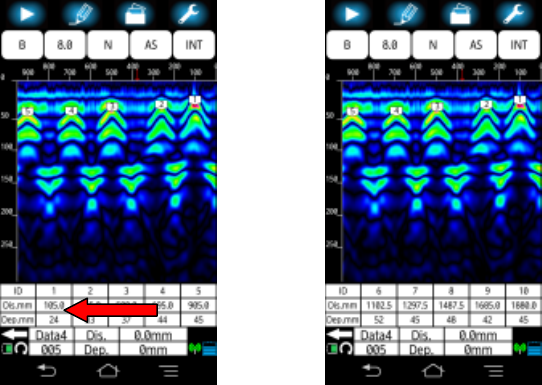
41
4.3.3. Marker list
You can show the marker list below B mode screen which displays the marker ID number,
distance coordinate, and depth coordinate of all added markers. The mark list can be
hidden. For the detail, refer to Section 4.13.2 [Show marker list] menu. For the unit of the
distance and depth coordinate, refer to Section 4.5.2 [Unit] menu. The marker list displays
5 markers in one screen. You can scroll the marker list as shown in Figure 4-5 Marker list
scroll.
1)Scroll right hand side 2)Marker list displayed from ID5
Figure 4-5 Marker list scroll
)
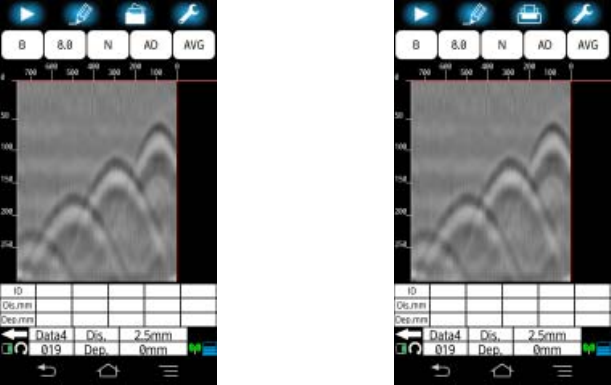
43
4.4. [File/Print] icon
By tapping [File/Print] icon, you can output the scan result to the file or the external printer
in accordance with the output destination setting. The icon shape of [File/Print] icon
indicates the current output destination setting: Folder symbol (Figure 4-7 1)) shows the
destination being set to the file (binary or ASCII) and Printer symbol (Figure 4-7 2)) shows
the destination being set to the printer. For the detail to set the output destination, refer to
Section 5 External output.
The factory setting (initialized by [Initial setting] menu. Refer to 4.11.21 Other: [Initial
setting] menu) of the output destination is set to the file of binary under the folder “data 1” in
Smartphone memory card.
1) Folder symbol 2)Printer symbol
Figure 4-7 [File/Print] icon indication
)
)
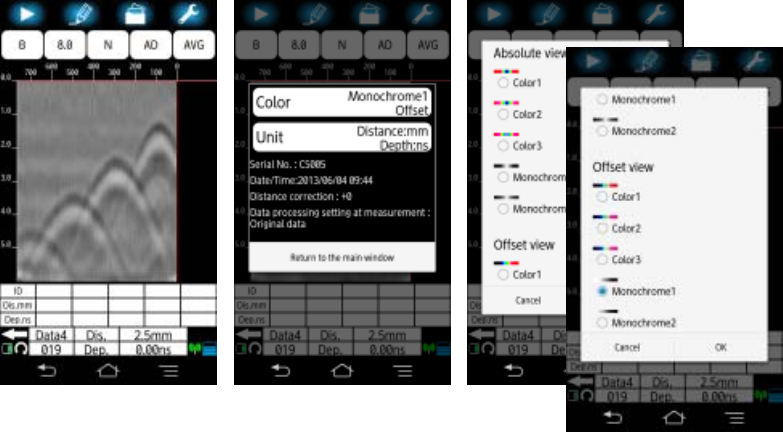
44
4.5. [Parameter] icon
By tapping [Parameter] icon at the idle state (not scanning), you can change the display
color and unit settings of B mode screen.
(The setting made by this icon is valid only for the scan result image displayed at the idle
state. After starting a new scan, the setting for the measurement called as the device
setting are restored. For the setting as the device setting, refer to Sections 4.11.5 Device
setting: [Color] menu and 4.11.7 Device setting: [Unit] menu.)
This section describes the procedure to set color and unit by using [Parameter] icon at the
idle state.
4.5.1. [Color] menu
[Color] menu allows you to set the color and gradation of the scan image on the main
screen. You can set the color and gradation with the following procedure.
(1) Tap [Parameter] icon at the main screen, then the display setup screen appears.
(2) Tap [Color] menu, then the color setup screen appears. The mark ● shows the
current setting.
(3) Tap a desired color. Then confirm the mark ● attached to the selected setting.
(4) Tap [OK] to return to the main screen. To cancel the setting change, tap [Cancel],
then you can return to the main screen without the setting change.
1) Tap [Parameter] icon. 2) Display setup screen 3) Color setup screen
Figure 4-8 Display color setting (1/2)
)
)
)
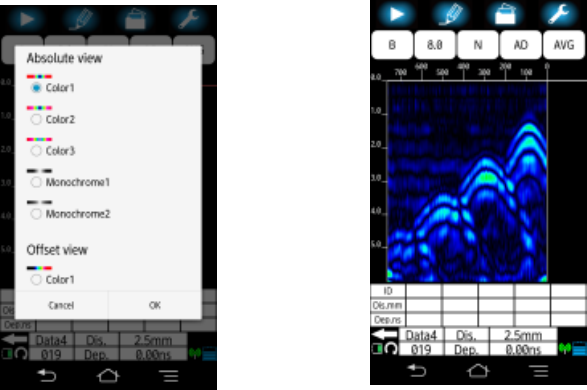
45
4) Tap [OK]. 5) Main screen after the color setup.
Figure 4-8 Display color setting (2/2)
)
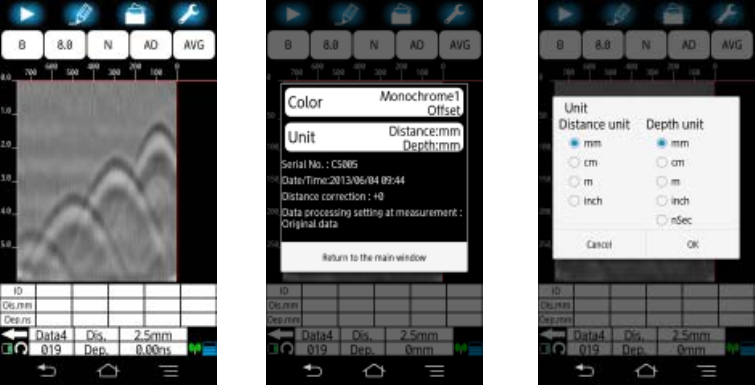
46
4.5.2. [Unit] menu
[Unit] menu allows you to set the unit of both depth and distance scales on the main result.
You can set the unit with the following procedure.
(1) Tap [Parameter] icon at the main screen, then the display setup screen appears.
(2) Tap [Unit] menu, then the unit setup screen appears. The mark ● shows the
current setting.
(3) Tap a desired unit for distance and depth scales, respectively. Then confirm the mark
● attached to the selected setting.
(4) Tap [OK] to return to the main screen. To cancel the setting change, tap [Cancel],
then you can return to the main screen without the setting change.
1) Parameter icon 2) Display setup screen 3) Unit setup screen
Figure 4-9 Unit setting (1/2)
)
)
)
)
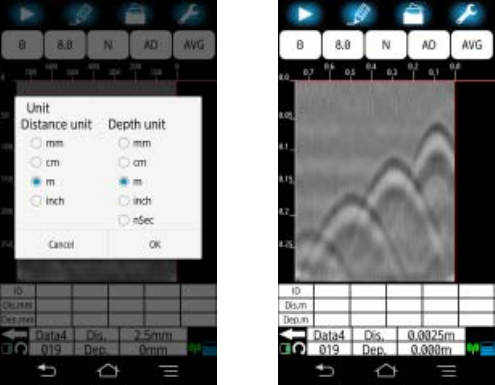
47
4) Tap [OK]. 5) Main screen after the unit setup
Figure 4-9 Unit setting (2/2)
)
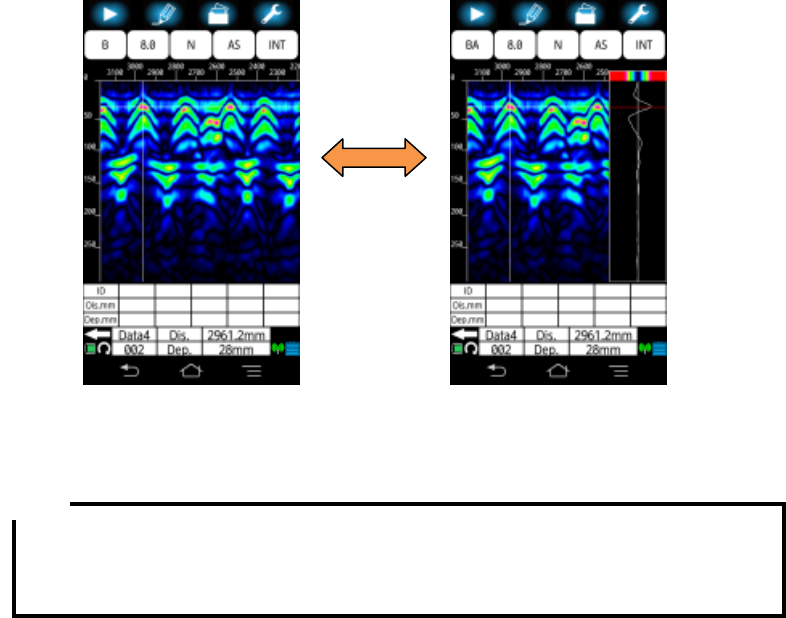
48
4.6. [Display mode] icon
At the idle state (not scanning), you can switch the display mode by tapping [Display
mode] icon. This product supports two display modes. One is B-mode which displays only
the vertical cross section. The other is BA-mode which displays both the vertical cross
section and the reflected waveform.
The current setting is shown on the label of the icon. When B-mode is selected, the label is
displayed as shown in Figure 4-10 1). To change the display mode, tap [Display mode]
icon. Then the display mode can be changed between BA mode and B-mode.
A mode waveform shown in BA mode shows the received signal waveform (reflected from
the object) at the B-mode cursor position.
1) B mode 2) BA mode
Figure 4-10 Display mode setting
y You can change the display mode between BA-mode and B-mode after the scan.
The scan result scanned in B-mode can be displayed in BA-mode and vice versa
by switching the display mode after the scan.
Note
)
)
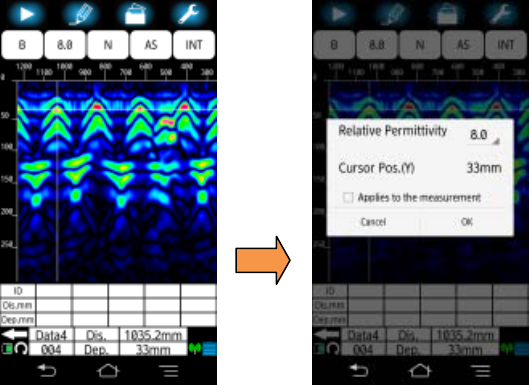
49
4.7. [Relative permittivity] icon
[Relative permittivity] icon allows you to set the relative permittivity (dielectric constant) of
the scanned concrete for the scan result at the idle state and to perform the depth
calibration. (The setting made by this icon is valid only for the scan result image displayed
at the idle state. After starting a new scan, the setting for the measurement is restored to
the original device setting. For more details on device setting, refer to
Section 4.11.1 Device setting: [Relative permittivity] menu.)
The available range of the relative permittivity is from 2.0 to 20.0. (Refer to
Section 4.7.1 Relative permittivity.) The current setting is shown on the label of the
icon. Figure 4-11 shows the example of the icon label of the relative permittivity setting 8.0.
You can set the relative permittivity with the following procedure.
(1) Tap [Relative permittivity] icon. The relative permittivity setup screen appears
(Figure 4-11) which shows the current setting.
(2) Tap the current setting (8.0 in Figure 4-11), then a list of available values appears.
(3) Scroll the list, tap the desired value, and confirm the selected value shown as current
setting.
(4) Tap [OK] to return to the main screen. To cancel the setting change, tap [Cancel],
then you can return to the main screen without the setting change.
To reflect the selected value to the setting as the device setting, tap [□ Applies to the
measurement] in the relative permittivity setup screen, then confirm that 9is attached in
[□]. Then tap [OK] to return to the main screen.
1) Tap [Relative permittivity] icon 2) Relative permittivity setup screen
Figure 4-11 Relative permittivity setup screen
)
)

50
4.7.1. Relative permittivity and depth calibration
The relative permittivity is an object-specific coefficient showing the relationship between
the electromagnetic propagation speed in the air and scanned medium. This product
measures the time between the time of transmitting the signal and the time receiving the
signal reflected at the embedded object, then calculates the depth of the embedded object
by using the measured time and electromagnetic propagation speed determined by the
relative permittivity of the scanned medium Depending upon the relative permittivity
entered, this product can correct the depth scale on the scan screen. Therefore setting the
appropriate value to the relative permittivity is the key factor to get the accurate depth of
the detected object. For the theory of operation, refer to 8 Theory.
Depth calibration is performed by estimating the relative permittivity of the scanned
concrete and setting the value to the relative permitivity. When the relative permittivity of
the scanned concrete is known, enter the known value to the relative permittivity. For the
setting procedure, refer to Sections 4.7 [Relative permittivity] icon and 4.11.1 Device
setting: [Relative permittivity] menu.
To reduce depth error when the relative permittivity of the scanned concrete is unknown,
perform the depth calibration before the scanning with the following procedure.
(1) Scan the object whose actual depth is known (Ex. the rebar with a known depth or a
wall with the known width) and detect the depth of the object.
(2) Adjust the relative permittivity value so that the depth displayed in the scan result
matches with the known depth.
When the object with a known depth is not avaialble and the relative dielectric constant of
the concrete is unclear, it is recommended to set 8.0 (+0) as the relative permittivity.
y The relative permittivity depends on the condition (such as moisture content) of
the concrete being scanned. Therefore the more difference between the actual
relative dielectric constant of the concrete and the entered value, the more the
depth error. Set an appropriate value to this parameter to get the accurate depth.
Note
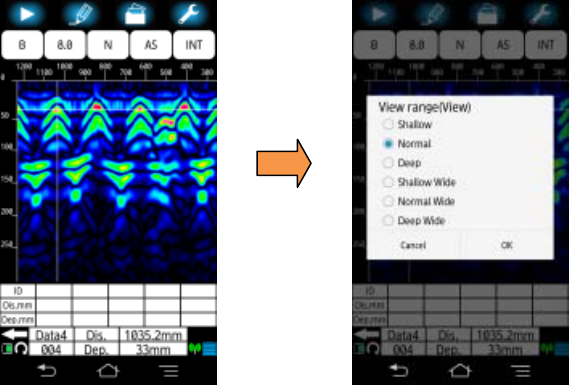
51
4.8. [View range] icon
[View range] icon allows you to change the view range for the scan result displayed at the
idle state. (The setting made by this icon is valid only for the scan result image displayed at
the idle state. After starting a new scan, the setting for the measurement is restored to the
original device setting. For the setting as the devie setting, refer to Section 4.11.3 Device
setting: [View range] menu.)
The view range specifies the displayed range of depth and distance in B mode screen.
Select the adequate range matched with the depth of the scan target as follows. The
available settings are Shallow, Normal, Deep, Shallow Wide, Normal Wide, and Deep
Wide.
Depth of the scan target 30 cm or less: Deep or Deep Wide
Depth of the scan target20 cm or less: Normal or Normal Wide
Depth of the scan target10cm or less: Shallow or Sallow Wide
The current setting is shown on the label of the icon. Figure 4-12 shows the label of the
icon displayed for the current setting: N (Normal). You can set the view range with the
following procedure.
(1) Tap [View range] icon, then the view range setup screen shown in Figure 4-12
appears. The mark ● shows the current setting.
(2) Tap the desired setting, and confirm the mark ● attached to the selected setting.
(3) Tap [OK] to return to the main screen. To cancel the setting change, tap [Cancel],
then you can return to the main screen without the setting change.
1) Tap [View range] icon 2) View range setup screen
Figure 4-12 View range setting
)
)
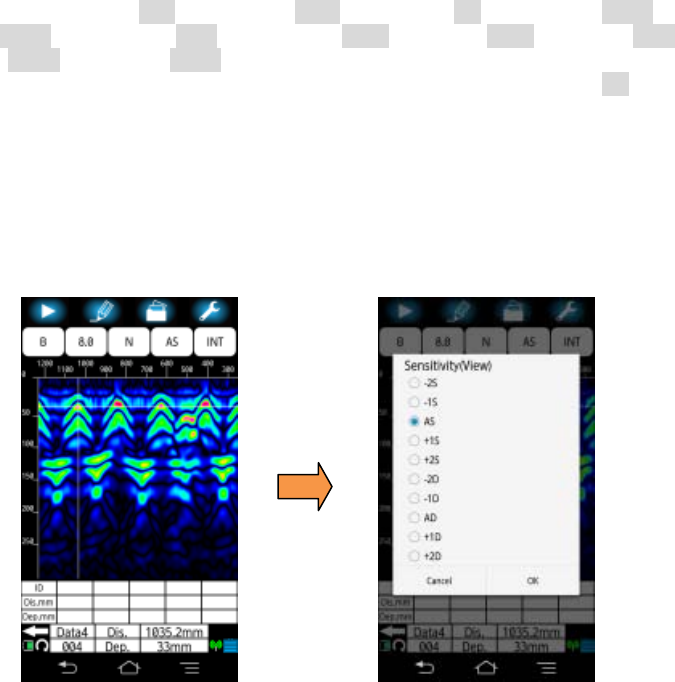
52
4.9. [Sensitivity] icon
[Sensitivity] icon allows you to change the sensitivity (display gain) of the received wave
for the scan result image displayed at the idle state. (The setting made by this icon is valid
only for the scan result dispayed at the idle state. After starting a new scan, the setting for
the measurement is restored to the original device setting. For the setting as the device
setting, refer to Section 4.11.2 Device setting: [Sensitivity] menu.)
The available settings are -2S (-2, shallow), -1S (-1, shallow), AS (A, shallow), +1S (+1,
shallow), +1S (+1, shallow ), +2S (+2, shallow), -2D (-2, deep), -1D (-1, deep), AD
(A, deep), +1D ( +1, deep), +2D (+2, deep). The current setting is shown on the label of
the icon. Figure 4-13shows the label of the icon displayed for the current setting: AS .
You can set the sensitivity with the following procedure.
Tap [Sensitivity] icon, then the sensitivity setup screen shown in Figure 4-13
(1) Figure 4-13 appears. The mark ● shows the current setting.
(2) Tap the desired setting, and confirm the mark ● attached to the selected setting.
(3) Tap [OK] to return to the main screen. To cancel the setting change, tap [Cancel],
then you can return to the main screen without the setting change.
1) Tap [Sensitivity] icon 2) Sensitivity setup screen
Figure 4-13 Sensitivity setup screen
)
)
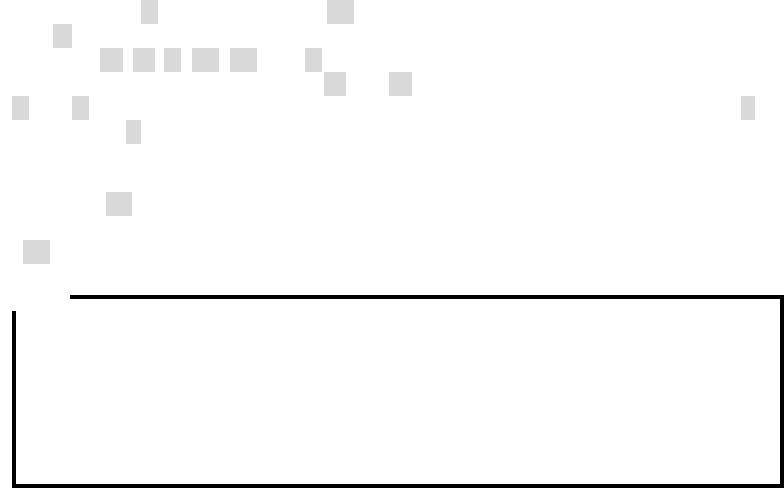
53
4.9.1. Sensitivity
The first letter A of the setting name AS indicates the overall sensitivity, and the second
letter S (Shallow) indicates the sensitivity by the depth. The overall sensitivity consists of
five levels: -2 , -1 , A , +1 , +2 . The A setting is the middle of all overall sensitivity settings
and is used normally. Use the +side (+1 and +2) to increase the sensitivity and the –side
(-2 and -1) to reduce the sensitivity. The sensitivity by the depth consists of two levels: S
(shallow) and D (deep). Select shallow when scanning the object at a depth less than 10
cm and deep when scannning the object at a depth of 10 cm or more.
The setting AS (A Shallow) is appropriate for scanning the steel bar at the depth less than
10 cm in the normal concrete. The initial sensitivity setting (default) at the factory shipment
is AS (A Shallow).
y The setting made by [Sensitivity] icon is valid only for the scan result displayed at
the idlestate. After starting a new scan, the setting for the measurement is
restored to the original device setting.. For the setting as the device setting, refer
to Section 4.11.2 Device setting: [Sensitivity] menu.
y When NJJ-200 application boots up, the sensitivity setting is set to the same as
the settings of the device setting.
Note
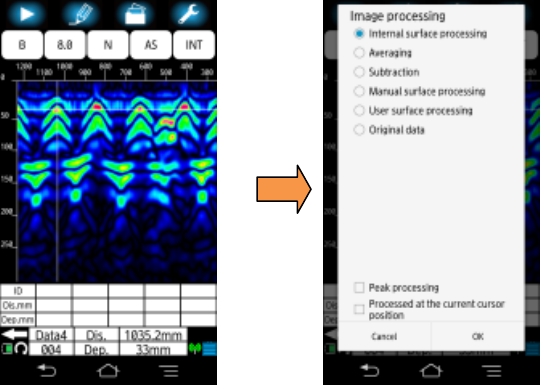
54
4.10. [Image processing] icon
[Image processing] allows you to set the image processing for the scan result displayed
at the idle state. (The setting made by this icon is valid only for the scan result dispayed
at the idle state. After starting a new scan, the setting for the measurement is restored to
the original device setting.. For the setting as the devie setting, refer to
Section 4.11.4 Device setting: [Image processing] menu.)
For the available image processing, refer to Section 4.10[Image processing] icon. The
current setting is shown on the label of the icon. Figure Figure 4-14 shows the label of the
icon displayed for the current setting: Fixed Surface Wave Image Processing.
You can set the image processing with the following procedure.
Tap [Image processing] icon, then the image processing setup screen shown in Figure
4-14
(1) Figure 4-14appears. The mark ● shows the current setting.
(2) Tap the desired setting, and confirm the mark ● attached to the selected setting.
(3) Tap [OK] to return to the main screen. To cancel the setting change, tap [Cancel],
then you can return to the main screen without the setting change.
For the details of the image processing, refer to Sections 4.10.1 to 4.10.8.
1) Tap [Image processing] icon 2) Image processing setup screen
Figure 4-14 Image processing setup screen
)
)
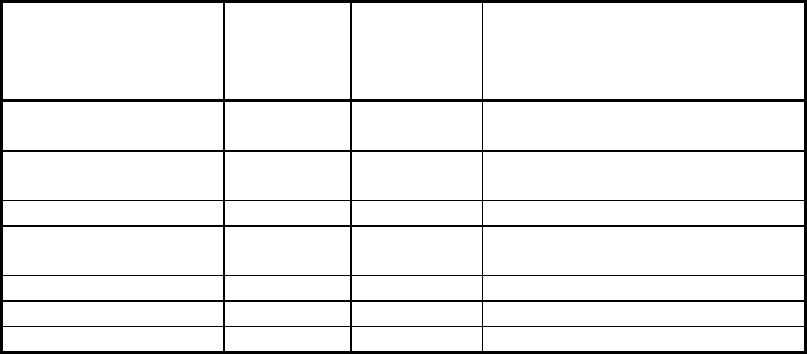
55
4.10.1. Image processing
The original scan data includes always unnecessary reflected signals (for example, the
reflection wave from the concrete surface (surface reflection wave) or reflection wave from
the boundary of concrete layers) which is commonly distributed over the scan image.
These unnecessary reflection waves make the image decoding difficult.
Image processing aims to remove or reduce the unnecessary reflection waves by data
processing (subtraction, averaging, and so on) and to provide easy deciphering of objects
that are being probed from the scan result.
This product supports the image processing listed in Table 4-2. Three image processing
can be performed in real time during scanning. The other image processing are
applicable to the scan result only at the idle state. Peak processing is applied to the image
data obtained by an image processing. Table 4-2 shows which image processing is
applicable in real-time during scanning and can be combined with the peak processing.
For the image processing applicable at the idle state, refer to Section 4.10 [Image
processing] icon. For the image processing applicable in real-time during scanning, refer
to Section 4.11.4 Device setting: [Image processing] menu.
This section describes the details of each image processing.
Table 4-2 Image processing
Image processing Applicable
in the scan
Combination
with Peak
processing
applicable
Users Guide (Reference)
Fixed surface
processing
✔ ✔ 4.10.2 Fixed surface processing
User surface
processing
✔ ✔ 4.10.3 User surface processing
Subtraction processing ✔ 4.10.4 Subtraction
Manual surface
processing
✔ 4.10.5 Manual surface processing
Average processing ✔ 4.10.6 Averaging
Peak processing 4.10.7 Peak processing
Original image ✔ ✔ 4.10.8 Original image

56
4.10.2. Fixed surface processing
This image processing subtracts the predefined data of the typical concrete surface
reflection wave from the displayed scan data. Usually it can reduce the concrete surface
reflection wave to provide easy image decoding.
The predefined data used in this image processing is called the fixed surface reflection
wave which is generated at the factory by using typical concrete and is stored in the
non-volatile memory of the sensor unit.
y The scan result file stored into the data storage contains the raw scan data, the
information about the selected image processing, and the fixed surface wave data
used for the image processing. When the data is recalled from the file, NJJ-200
application displays the scan image by using the recalled data (raw scan data, the
image processing setting, and the fixed surface wave data). After scanning,
NJJ-200 application displays the scan image obtained by performing the selected
image processing and the fixed surface wave data prepared in the sensor unit.
4.10.3. User surface processing
This image processing subtracts the user defined surface reflection wave from the raw
scan data. The user defined surface reflection wave is registered by selecting a point in the
actual scan data. Then this image processing subtracts the actual reflection wave selected
in the scan data, so that it can reduce the affection (noise) of the concrete surface
reflection wave more accurately than the fixed surface wave processing.
The user surface reflection wave can be defined and registered by the following
procedure.
(1) Scan the concrete. After the scan completed, the scan result image is displayed on
the screen.
(2) Move the cursor to the area on the scan result image where you want to do the
processing. Make sure not to put the cursor directly on the point with a reflection
signal (echo) from any embedded objects.
(3) Tap [Image processing] icon. Then the image processing setup screen appears.
(4) Tap User surface processing and confirm that the mark ● is attached to the
selected setting. Then tap [□Processed at the current cursor.] and confirm that a
mark 9is displayed in the [□].
(5) Tap [OK]. Then a message “Are you sure to update the user surface wave
data?” [Cancel] [OK] appears. Tap [OK].
(6) A message “Saving user surface wave data completed” appears. Then tap [OK]
to return to the main screen.
Note
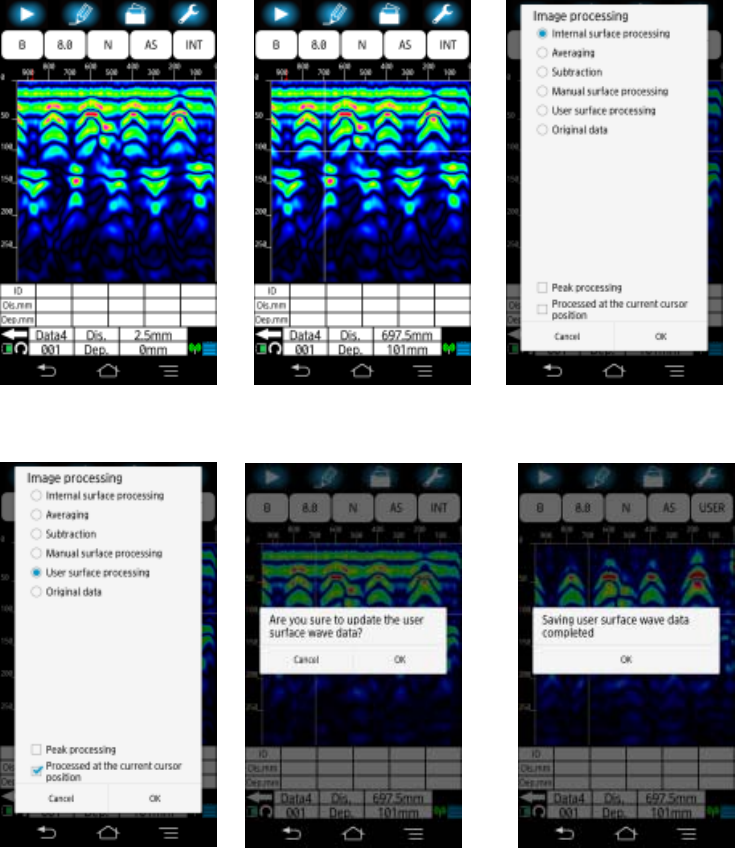
57
Here the registration of a user surface wave data has been completed. The label of
[Image processing] icon shows USER as the current setting.
1) Complete a scan 2)Select a position 3) Image processing setup screen
4)Select user surface wave 5) Tap [OK]. 6) Tap [OK].
Image processing
Figure 4-15 User surface wave registration
)
)
)
)
)
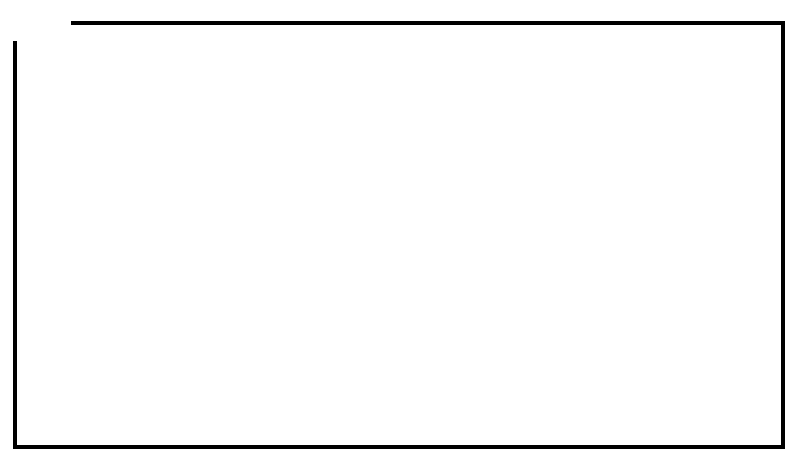
58
y The data file in the data storage contains the raw scan data, the image processing
setting, and the fixed surface wave data used in the image processing. When the
data is recalled from the data file, the scan result image is displayed by using the
recalled data (raw scan data, the image processing setting, and the fixed surface
wave data). However, the NJJ-200 application will displayany newly scanned
images by using the image processing and the fixed surface wave data prepared
in the sensor unit’s settings.
y You can register a point in the recalled scan result as the user surface wave. After
recalling the scan result, perform the procedure above to register a point of the
recalled scan result as the user surface wave.
y When the point showing some reflection signal from the embedded object is
registered as the user surface wave, the image processing may produce
unwanted noise on the scan result image.
y When the unwanted noise appears after the image processing, register a different
point with no reflection signal on the scan result as the user surface wave.
Note
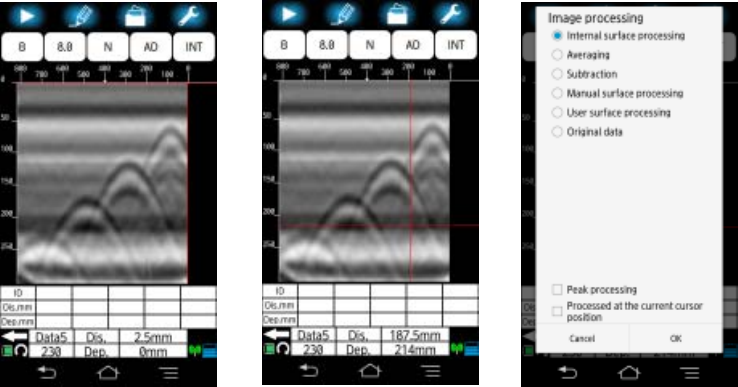
59
4.10.4. Subtraction
This image processing is used to reduce the horizontal band noise of the reflection wave
appearing at the depth more than 20 cm as shown Figure 4-16 1). You can use this image
processing with the procedure below.
(1) Scan the concrete. After the scan completed, the scan image is displayed on the
main screen.
(2) Move the cursor to the area on the scan result image where you want to do the
processing. Make sure not to put the cursor directly on the point with a reflection
signal (echo) from any embedded objects.
(3) Tap [Image processing] icon. Then the image processing setup screen appears.
(4) Tap [Subtraction] and confirm that the mark ● is attached to the selected setting.
Then tap [□Processed at the current cursor.] and confirm that the mark 9is
displayed in the [□].
(5) Tap [OK] to return to the main screen.
Here NJJ-200 application executes the subtraction processing by using the data specified
at the step (2) above and shows the image after the processing. (The label of [Image
processing] icon shows SUB.) The mark È is shown at the point selected as the
subtraction data on the distance scale.
1) Complete a scan 2)Select a position 3) Image processing setup screen
Figure 4-16 Subtraction (1/2)
)
)
)
)
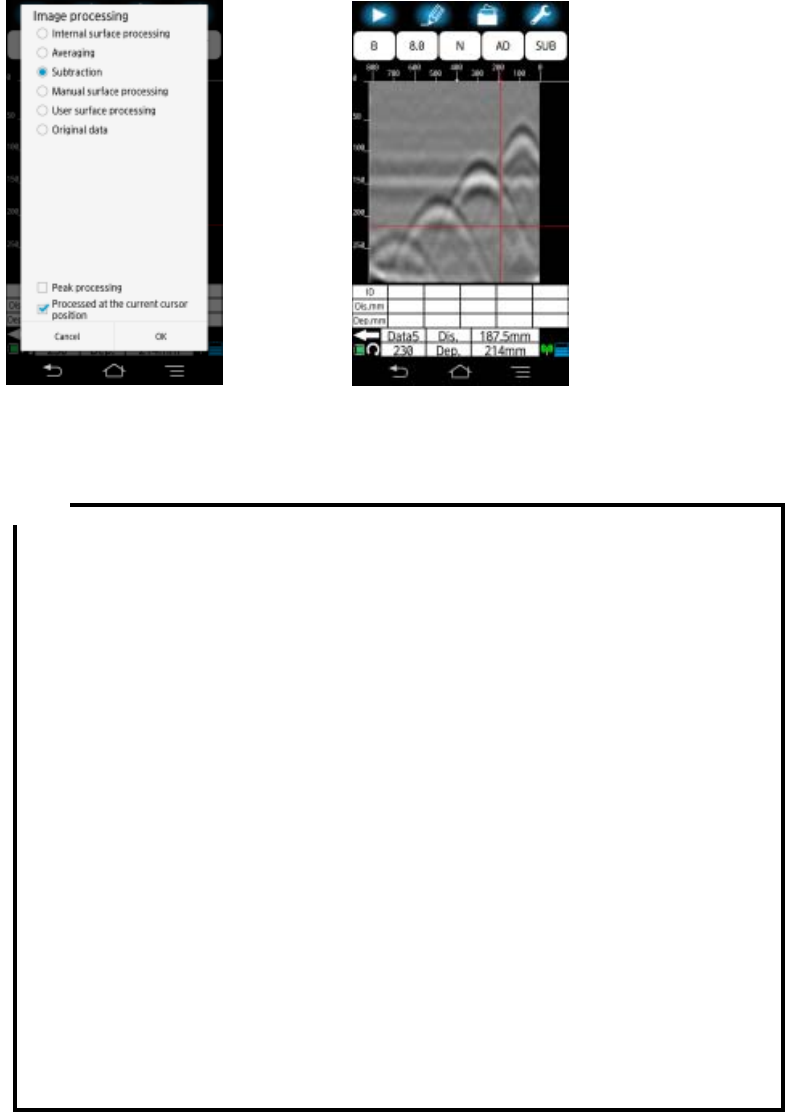
60
4) Tap [OK]. 5) Image after processing
Figure 4-16 Subtraction (1/2)
y When tapping [OK] without the mark 9 at [□Processed at the current cursor]
at the step 4) above, a message “No processing point defined” appears and
the processing is canceled.
y When re-executing the manual surface wave processing or the subtraction
processing (including real-time manual subtraction processing) without the mark
9 at [□Processed at the current cursor], the processing is executed by using
the reflection wave data previously registered and shown by the cursor mark È on
the distance scale. To change the reflection wave data used for the processing,
perform the steps 2) to 4) above.
y For the real-time subtraction processing, refer to Section 3.4 Interpreting the scan
result.
y The processing of the manual surface processing is almost same as that of the
subtraction processing. The difference is that the manual surface processing
subtracts the surface reflection wave data from the scan result only for the depth
range of 0 mm to 200 mm. The subtraction processing subtracts the surface
reflection data from the scan result over all depth range.
y The subtraction processing may remove the reflection wave from the opposite
side of the concrete wall.
y For the manual surface processing, refer to Section 4.10.5 Manual surface
processing.
y When the registered surface reflection wave contains some signal reflected from
the embedded object, the processing may produce the unwanted noise.
Note
)
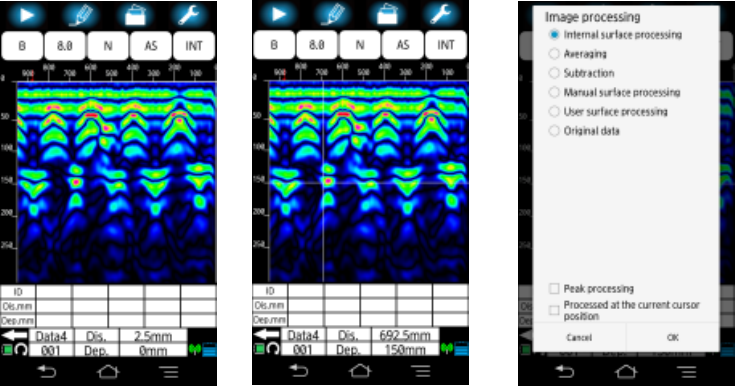
61
4.10.5. Manual surface processing
This image processing is used to reduce the remained noise even after an image
processing (Refer to Figure 4-17 1)) . This image processing subtracts the registered
surface reflection wave from the scan result only for the depth range of 0 mm to 200 mm.
You can perform this image processing with the following procedure.
(1) Scan the concrete. After the scan completed, the scan image is displayed on the
main screen.
(2) Move the cursor to the area on the scan result image where you want to do the
processing. Make sure not to put the cursor directly on the point with a reflection
signal (echo) from any embedded objects.
(3) Tap [Image processing] icon. Then the image processing setup screen appears.
(4) Tap Manual surface processing and confirm that the mark ● is attached to the
selected setting. Then tap [□Processed at the current cursor.] and confirm that the
mark 9is displayed in the [□] .
(5) Tap [OK] to return to the main screen.
Here NJJ-200 application executes the manual surface processing by using the reflection
wave data specified at the step (2) above and shows the image obtained by the
processing. The label of [Image processing] icon shows MNL. The mark È is shown at
the point selected as the subtraction data on the distance scale.
1) Complete a scan 2)Select a position 3) Image processing setup screen
Figure 4-17 Manual surface processing (1/2)
)
)
)
)
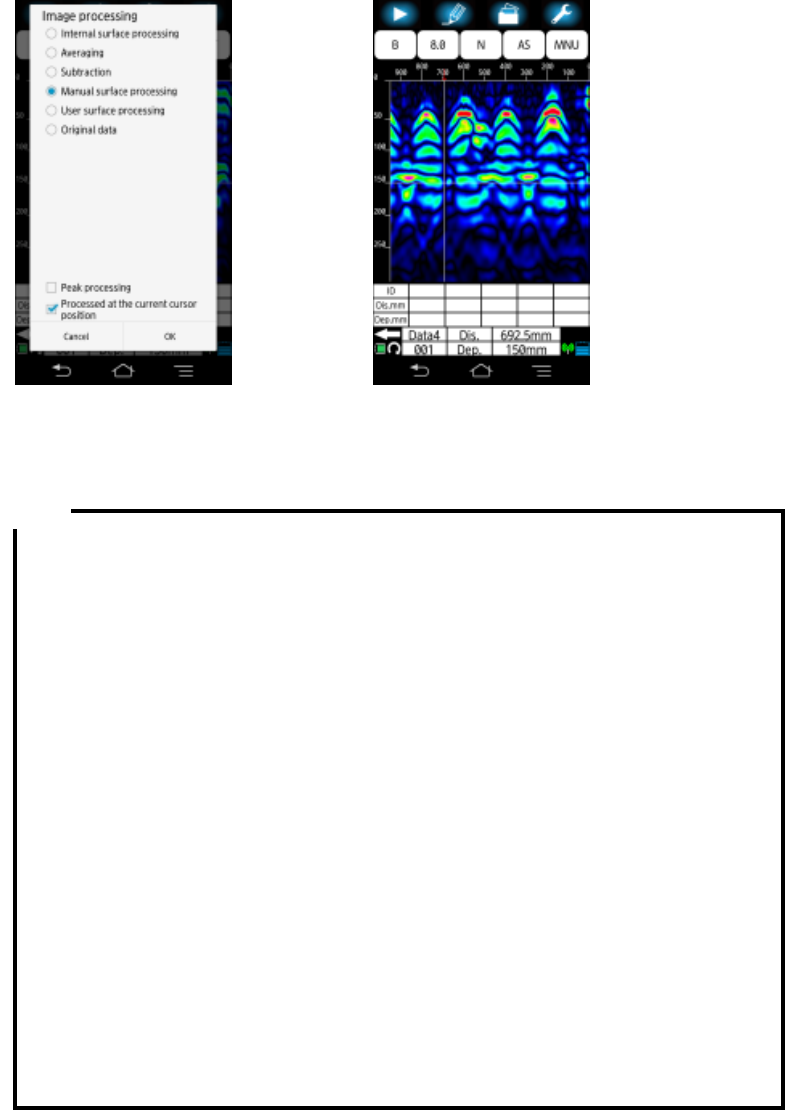
62
4) Tap [OK]. 5) Image after processing
Figure 4-17 Manual surface processing (1/2)
y When tapping [OK] without the mark 9 at [□Processed at the current cursor]
at the step 4) above, a message “No processing point defined” appears and
the processing is canceled.
y When re-executing the manual surface processing or subtraction processing
(including real-time manual subtraction processing) without the mark 9 at [□
Processed at the current cursor], the processing is executed by using the
reflection wave data previously registered and shown by the cursor mark È on the
distance scale. To change the reflection wave data used for the processing,
perform the steps 2) to 4) above.
y For the real-time subtraction processing, refer to Section 3.4 Interpreting the scan
result.
y The processing of the manual surface processing is almost same as that of the
subtraction processing. The difference is that the manual surface processing
subtracts the surface reflection data from the scan image only for the depth range
of 0 mm to 200 mm. The subtraction processing subtracts the surface reflection
data from the scan result over all depth range.
y The subtract processing may remove the reflection wave from the opposite side of
the concrete wall.
y For the manual surface wave processing, refer to Section 4.10.5 Manual surface
processing.
y When the registered surface reflection wave contains some signal reflected from
the embedded object, the processing may produce the unwanted noise.
)
Note
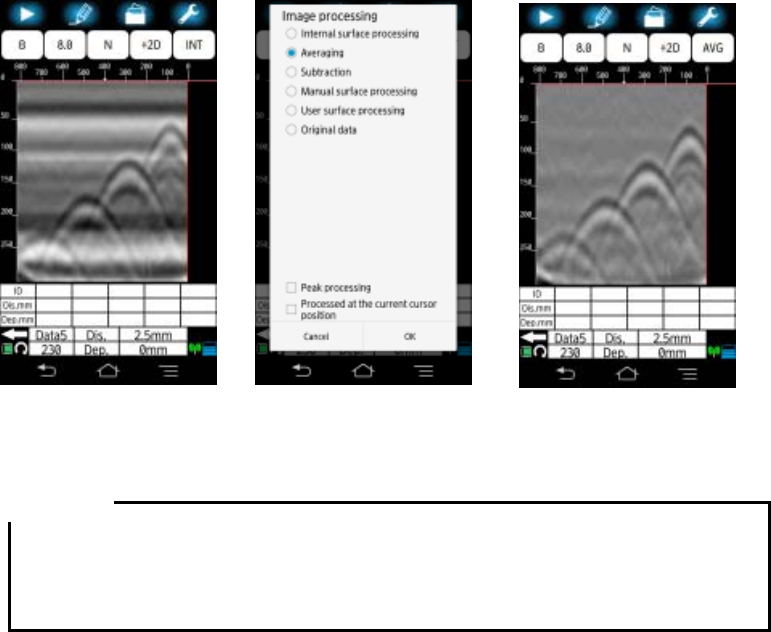
63
4.10.6. Averaging
This image processing is effective to reduce the horizontal line noise appearing uniformly
over the scan result. It subtracts the averaged wave of all scan points from the scan result
and displays the processed image. This processing may remove the continuous reflection
signal appearing at the constant depth like the reflection from the opposite side of the
concrete wall. Use this processing by considering this point.
You can perform the average processing by the following procedure.
(1) Scan the concrete. After the scan completed, the scan image is displayed on the
main screen.
(2) Tap [Image processing] icon. Then the image processing setup screen appears.
(3) Tap Averaging and confirm that the mark ● is attached to the selected setting.
(4) Tap [OK] to return to the main screen.
Here NJJ-200 application executes the average processing and shows the image
obtained by the processing. The label of [Image processing] icon shows AVG.
1) Complete a scan 2) Image processing setup screen 3) Image after processing
Figure 4-18 Average processing
y This processing reduces the horizontal line noise appearing uniformly over the
scan result, so that it may remove the similar image of the continuous reflection
signal appearing uniformly at the constant depth like the reflection from the
opposite side of the concrete wall.
)
)
)
Caution
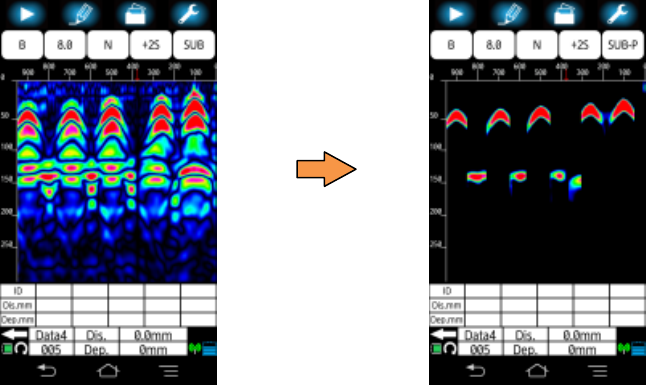
64
4.10.7. Peak processing
This image processing is effective to remove the unwanted image caused by the ringing in
the reflection wave from the detected object (steel bar) and to show the refection wave
only from the detected target. Use this processing when the depth of the detected object is
difficult to read due to the images of the ringing. This processing is not applicable to the
detection of the object (ex. cavity) with the relative permittivity lower than that of the
concrete. This processing is applicable to the processed image obtained by fixed surface
wave processing (including real-time surface wave processing), average processing,
subtract processing, manual surface wave processing, user surface wave processing, or
the original image.
Figure 4-19 shows the image after the peak processing applied for the image obtained by
the subtraction processing.
1)Before processing 2) After the processing
Figure 4-19 Peak processing
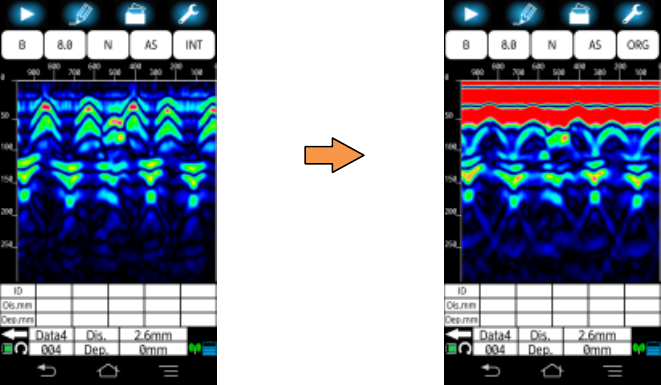
65
4.10.8. Original image
The original image shows the image of the raw scan result for which no image processing
is applied.
1) Before processing 2) After processing
Figure 4-20 Original image
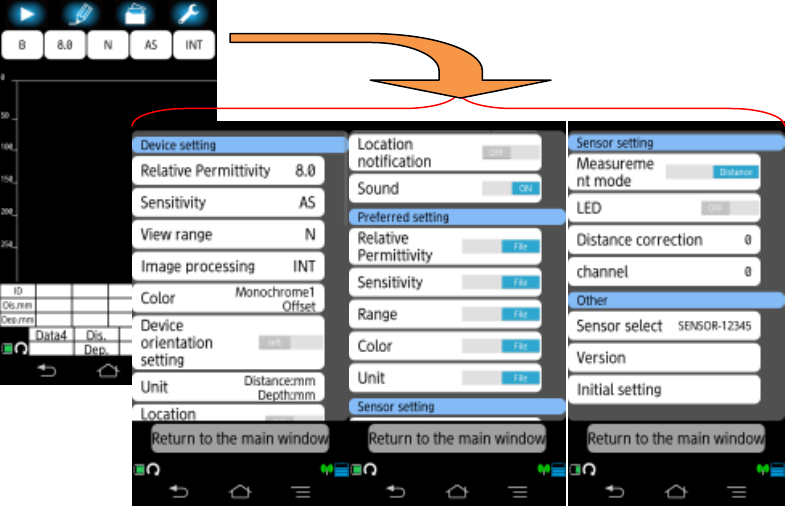
66
4.11. Parameter setup screen
The parameter setup screen allows you to set various conditions: relative permittivity and
sensitivity used in the scanning, and so on. To access the parameter setup screen, long
tap [Parameter] icon (Figure 4-1 ④) at the idle state (not scanning). Then the parameter
setup screen shown in Figure 4-21 appears on the screen. Scroll the screen and tap a
desired setting menu, then you can access each setup screen. After completing the setting,
you can return to the main screen by tapping [Return to the main screen].
Figure 4-21 Parameter setup screen
)
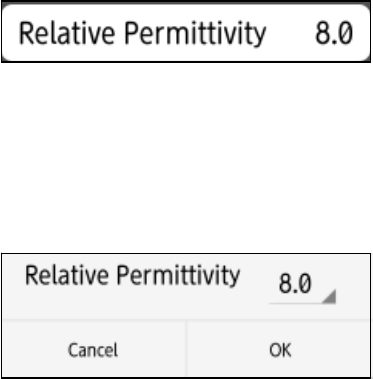
67
4.11.1. Device setting: [Relative permittivity] menu
Device setting: [Relative permittivity] menu (Figure 4-22) in the parameter setup screen
(Figure 4-21) allows you to set the relative permittivity of the scanned medium (ex.
concrete) used for the scan. (The relative permittivity used for the scan result image at
the idle state, refer to Section 4.7 [Relative permittivity] icon.) The menu shows the current
setting at the right hand. Figure 4-22 shows the case of the current setting: 8.0.
Figure 4-22 Device setting: [Relative permittivity] menu
The available range of the relative permittivity is from 2.0 to 20.0. You can change the
setting with the following procedure.
(1) Tap Device setting: [Relative permittivity] menu. Then the relative permittivity setup
screen (Figure 4-23) appears. The current setting is shown in the screen.
Figure 4-23 Relative permittivity setup screen
(2) Tap the setting value (8.0 shown in Figure 4-23). Then the list of the available setting
values appears.
(3) Scroll the list and tap a desired value as the relative permittivity.
(4) Confirm the selected value is shown in the screen as the current setting.
(5) Tap [OK] to return to the parameter setup screen. To cancel the setting change, tap
[Cancel], then the screen returns to the parameter setup screen without setting
change.
(6) Tap [Return to the main window] to return to the main screen.
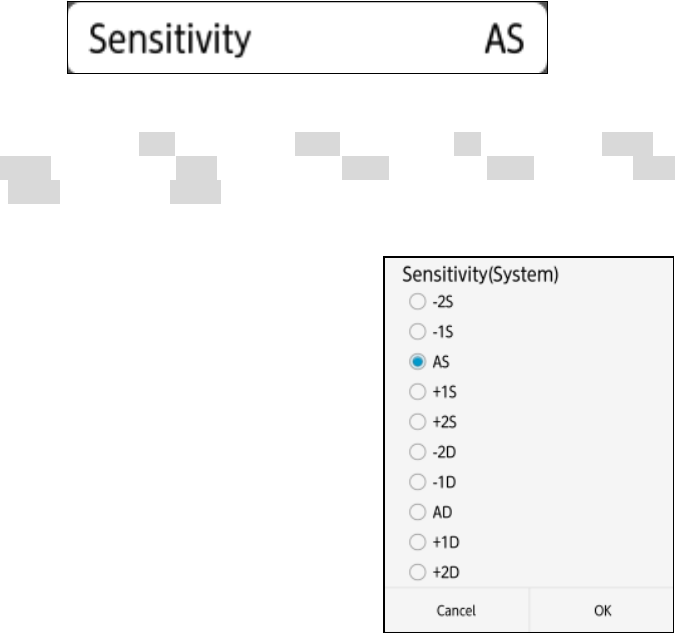
68
4.11.2. Device setting: [Sensitivity] menu
Device setting: [Sensitivity] menu (Figure 4-24) in the parameter setup screen (Figure
4-21) allows you to set the sensitivity used for the scan. (The sensitivity used for the scan
result image at the idle state, refer to Section 4.9 [Sensitivity] icon.) The menu shows the
current setting at the right hand. Figure 4-24 shows the case of the current setting: A
Shallow.
Figure 4-24 Device setting: [Sensitivity] menu
The available settings are -2S (-2, shallow), -1S (-1, shallow), AS (A, shallow), +1S (+1,
shallow), +1S (+1, shallow ), +2S (+2, shallow), -2D (-2, deep), -1D (-1, deep), AD
(A, deep), +1D ( +1, deep), +2D (+2, deep). For the details about each setting, refer
to 4.9.1 Sensitivity.
You can change the setting with the following
procedure.
(1) Tap Device setting: [Sensitivity] menu. Then
the sensitivity setup (device) screen
Figure 4-25) appears. The mark ● shows the
current setting.
(2) Tap a desired setting, and confirm the mark ●
is moved to the selected setting.
(3) Tap [OK] to return to the parameter setup
screen. To cancel the setting change, tap
[Cancel], then the screen returns to the
parameter setup screen without setting
change.
(4) Tap [Return to the main window] to return to
the main screen.
Figure 4-25 Sensitivity setup screen
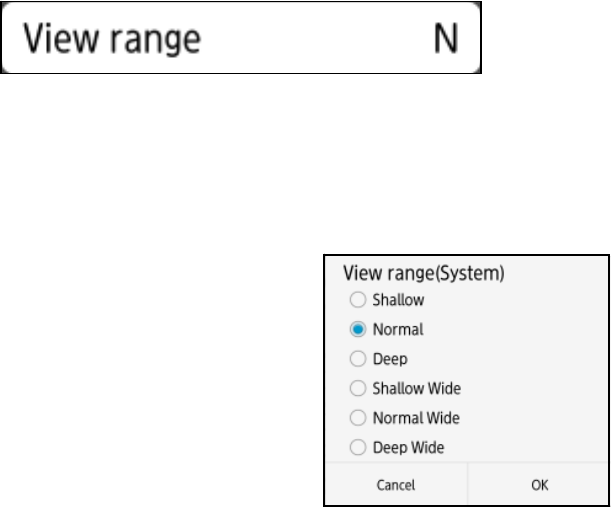
69
4.11.3. Device setting: [View range] menu
Device setting: [View range] (Figure 4-26) in the parameter setup screen (Figure 4-21)
allows you to set the view range used for the scan. (The view range used for the scan
result image at the idle state, refer to Section 4.8 [View range] icon.) The menu shows the
current setting at the right hand. Figure 4-26 shows the case of the current setting: N
(Normal).
Figure 4-26 Device setting: [View range] menu
The available settings are Shallow, Normal, Deep, Shallow Wide, Normal Wide, and Deep
Wide. For the detail about each setting, refer to Section 4.8 [View range] icon.
You can change the setting with the following procedure.
(1) Tap Device setting: [View range] menu. Then
the view range setup (device) screen (Figure
4-27) appears. The mark ● shows the
current setting.
(2) Tap a desired setting, and confirm the mark ●
is moved to the selected setting.
(3) Tap [OK] to return to the parameter setup
screen. To cancel the setting change, tap
[Cancel], then the screen returns to the
parameter setup screen without setting
change.
(4) Tap [Return to the main window] to return to
the main screen.
Figure 4-27 View range setup screen
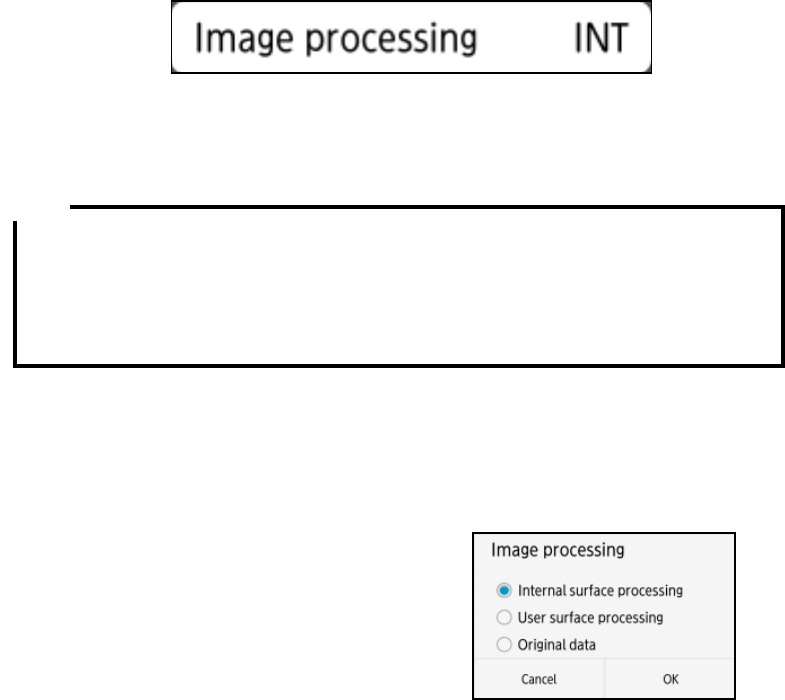
70
4.11.4. Device setting: [Image processing] menu
Device setting: [Image processing] menu (Figure 4-28) in the parameter setup screen
(Figure 4-21) allows you to set the image processing performed real time during the scan.
(The image processing applied for the scan result at the idle state, refer to
Section 4.10 [Image processing] icon.) The menu shows the current setting at the right
hand. Figure 4-28 shows the case of the current setting: FIX (Fixed surface wave
processing).
Figure 4-28 Device setting: [Image processing] menu
The available settings are Fixed surface processing, User surface processing, and Original
image.
y For more information about the image processing listed above , refer to the
following sections.
4.10.2 Fixed surface processing
4.10.3 User surface processing
4.10.8 Original image
You can change the setting with the following procedure.
(1) Tap Device setting: [Image processing] menu. Then the image processing setup
screen (Figure 4-29) appears. The mark ● shows the current setting.
(2) Tap a desired setting, and confirm the mark ● is moved to the selected setting.
(3) Tap [OK] to return to the parameter setup
screen. To cancel the setting change, tap
[Cancel], then the screen returns to the
parameter setup screen without setting
change.
(4) Tap [Return to the main window] to return
to the main screen.
Figure 4-29 Image processing setup screen
Note
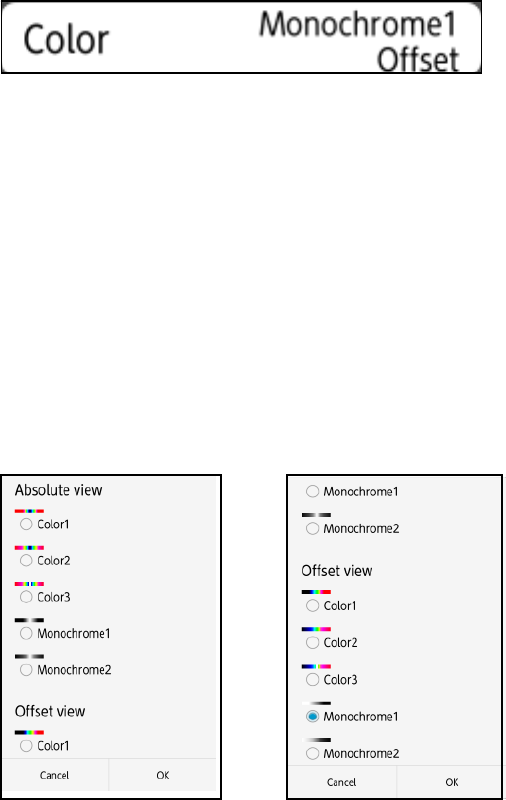
71
4.11.5. Device setting: [Color] menu
Device setting: [Color] menu (Figure 4-30) in the parameter setup screen (Figure 4-21)
allows you to set the display color applied to the scan result image during the scanning.
(The view range applied for the scan result at the idle state, refer to Section 4.5.1 [Color]
menu.) The menu shows the current setting at the right hand. Figure 4-30 shows the
case of the current setting: Color 1 Abs (Color 1 Absolute).
Figure 4-30 Device setting: [Color] menu
The available settings are listed below. The color mapping for each setting are provided at
the end of this section.
y Absolute gradation: Color 1, Color 2, Color 3, Monochrome 1, and Monochrome 2
y Offset gradation: Color 1, Color 2, Color 3, Monochrome 1, and Monochrome 2
You can change the setting with the following procedure.
(1) Tap Device setting: [Color] menu. Then the display color screen (Figure 4-31)
appears. The mark ● shows the current setting.
(2) Tap a desired setting, and confirm the mark ● is moved to the selected setting.
(3) Tap [OK] to return to the parameter setup screen. To cancel the setting change, tap
[Cancel], then the screen returns to the parameter setup screen without setting
change.
(4) Tap [Return to the main window] to return to the main screen.
Figure 4-31 Color setup screen
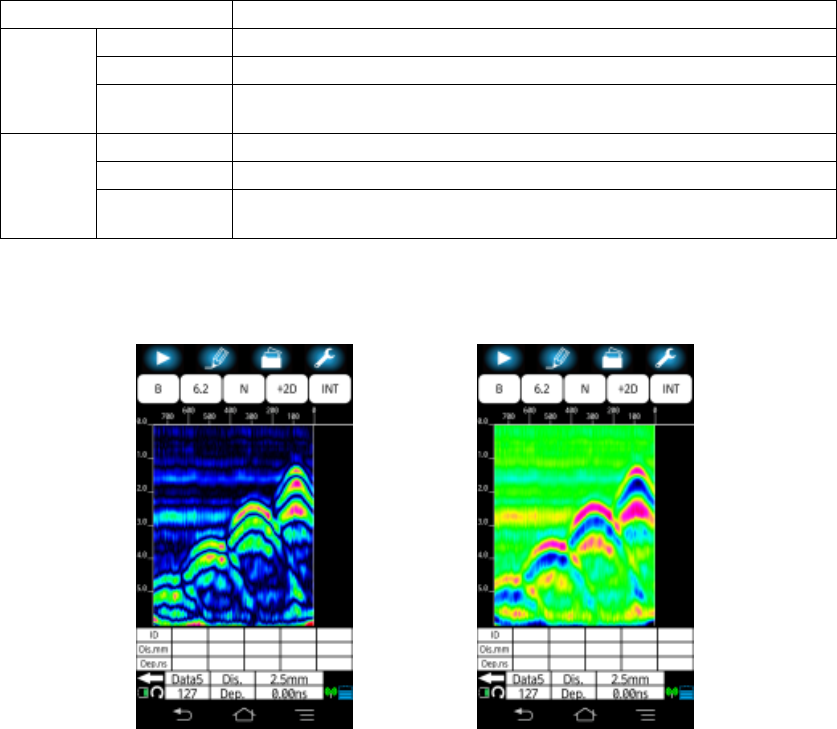
72
The color mapping for each setting are shown in Table 4-3. Figure 4-32 shows the image
comparison of Absolute color 1 and Offset color 1.
Table 4-3 Color map
Setting Left Center Right
Absolute
Color 1/2 Red Yel Gre Blu Bla Blu Gre Yel Red
Color 3 Red Yel Gre Blu Bla Whi Bla Blu Gre Yel Red
Monochrome
1/2 Bla ← Whi → Bla
Offset
Color 1/2 Bla → Blu →Gre → Yel → Red
Color 3 Bla →Blu →Gre Whi Gre → Yel → Red
Monochrome
1/2 Whi → Gra → Black
Where: Red: Red, Bla:Black, Whi:White, Yel:Yellow, Gre:Green, Blu:Blue, Gra:Gray
1) Absolute Color 1 2) Offset Color 1
Figure 4-32 Image Comparison
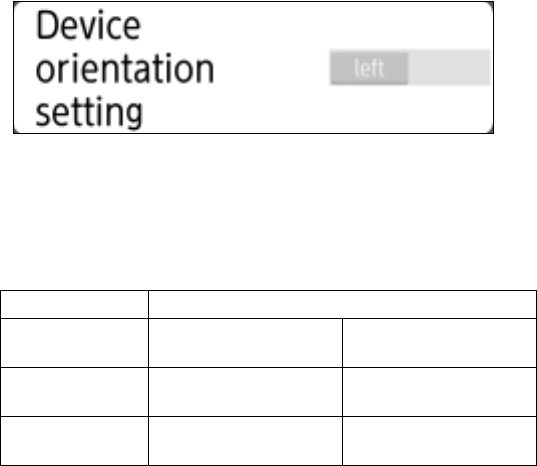
73
4.11.6. Device setting: [Device orientation setting] menu
Device setting: [Device orientation setting] menu (Figure 4-33) in the parameter setup
screen (Figure 4-21) allows you to set the distance scale direction for the device moving
orientation. The menu shows the current setting at the right hand. Figure 4-33 shows the
case of the current setting: Left.
Figure 4-33 Device setting: [Device orientation] setting menu
The available settings are Left and Right. Table 4-4 shows the relation between the device
moving orientation and distance scale.
Table 4-4 Device moving orientation and distance scale direction
Item Distance scale direction
Device moving
orientation
Device orientation
setting: Left
Device orientation
setting: Right
Forward From left to right on
the screen
From right to left on
the screen
Backward From right to left on
the screen
From Left to right on
the screen
You can change the setting with the following procedure.
(1) Tap Device setting: [Device orientation setting] menu. Then the setting alternates
between Left and Right.
(2) Confirm the selected setting shown as the current setting in the menu.
(3) Tap [Return to the main window] to return to the main screen.
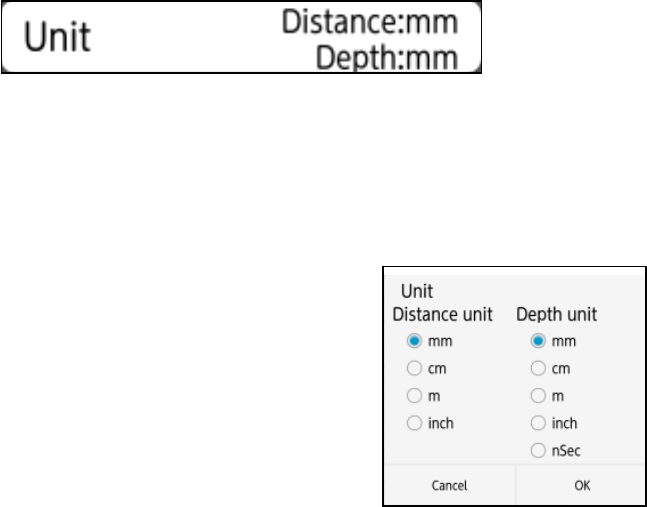
74
4.11.7. Device setting: [Unit] menu
Device setting: [Unit] menu (Figure 4-34) in the parameter setup screen (Figure 4-21)
allows you to set the unit of the distance scale (horizontal direction) and the depth scale
(vertical direction) displayed during the scan. (The unit setting of scales displayed at the
idle state, refer to Section 4.5.2 [Unit] menu.) The menu shows the current setting at the
right hand. Figure 4-34 shows the case of the current setting: distance scale (shown as X)
of mm and depth scale (shown as Y) of mm.
Figure 4-34 Device setting: [Unit] menu
The available settings are mm, cm, m, inch, nSec. Where nSec is applicable only to the
depth scale.
You can change the setting with the following procedure.
(1) Tap Device setting: [Unit] menu. Then the unit setup screen (Figure 4-35) appears.
The mark ● shows the current setting for the
distance and depth scales, respectively.
(2) Tap a desired setting, and confirm the mark ● is
moved to the selected setting.
(3) Tap [OK] to return to the parameter setup screen.
To cancel the setting change, tap [Cancel], then
the screen returns to the parameter setup screen
without setting change.
(4) Tap [Return to the main window] to return to the
main screen.
Figure 4-35 Unit setup screen
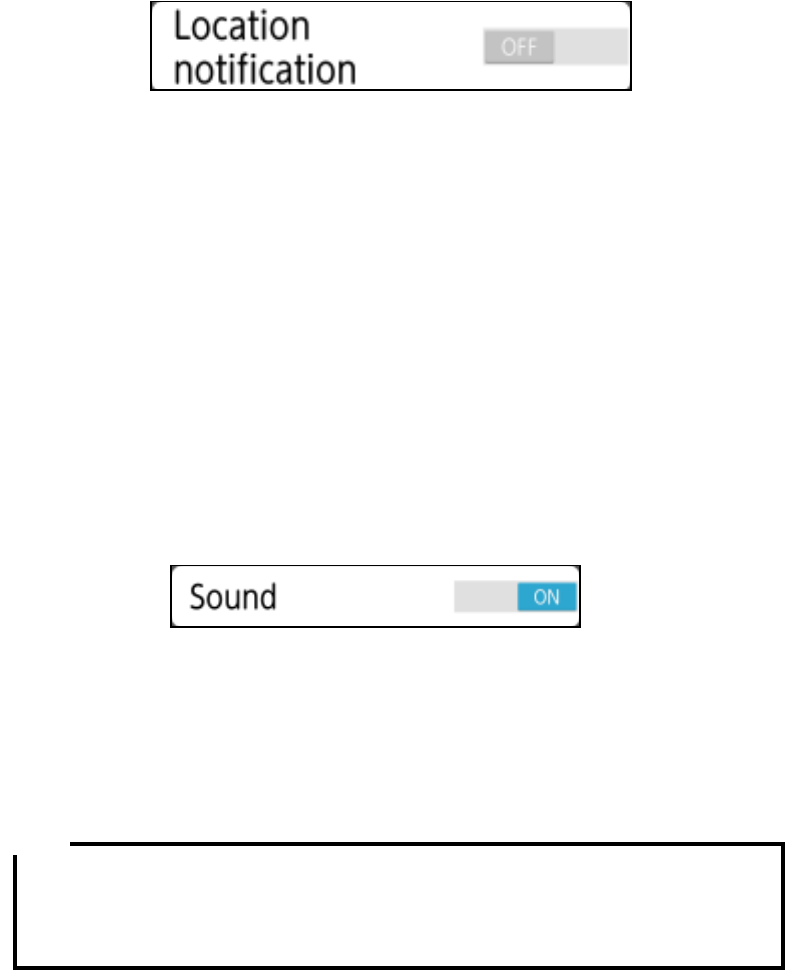
75
4.11.8. Device setting: [Location notification] menu
Device setting: [Location notification] menu (Figure 4-36) in the parameter setup screen
(Figure 4-21) allows you to turn the rebar detection assist function on and off. The menu
shows the current setting at the right hand. Figure 4-36 shows the case of the current
setting: OFF.
Figure 4-36 Device setting: [Location notification] menu
The rebar detection assist function helps you to detect the rebar easily. It detects
automatically rebars in the scan result and places a marker on the detected rebar. Also it
notifies the rebar position by blinking the LED of the front or rear panel of the sensor unit
and beeping when the fixed cursor (showing the position of the front or rear edge of the
sensor unit) superposes one of markers of the detected rebars. For details of the rebar
detection assist function, refer to Section 6.4 Location notification function.
You can change the setting with the following procedure.
(1) Tap Device setting: [Location notification] menu. Then the setting alternates
between ON and OFF.
(2) Confirm the selected setting is shown as the current setting in the menu.
(3) Tap [Return to the main window] to return to the main screen.
4.11.9. Device setting: [Sound] menu
Device setting: [Sound] menu (Figure 4-37) in the parameter setup screen allows you to
turn the sound of Smartphone on and off. The menu shows the current setting at the right
hand. Figure 4-37 shows the case of the current setting: ON.
Figure 4-37 Device setting: [Sound] menu
You can change the setting with the following procedure.
(1) Tap Device setting: [Sound] menu. Then the setting alternates between ON and
OFF.
(2) Confirm the selected setting is shown as the current setting in the menu.
(3) Tap [Return to the main window] to return to the main screen.
y When the ”Manner” mode of Smartphone is set to On, Smartphone does not
beep even when the sound setting is set to ON.
y When the touch tone setting of Smartphone is set to On, Smartphone beeps each
touch of the operation even when the sound setting is set to OFF.
Note
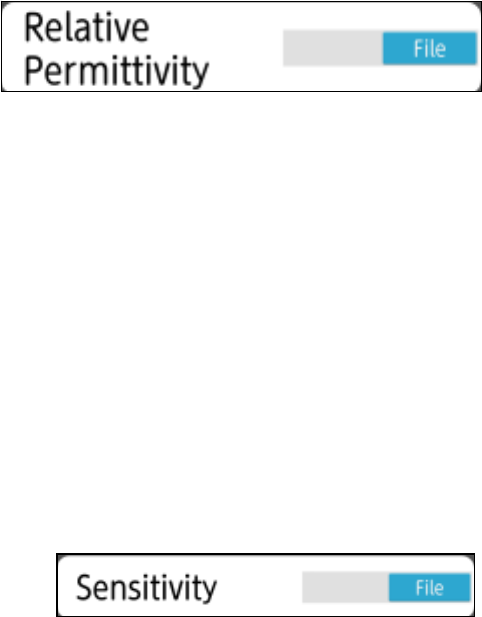
76
4.11.10. Preferred setting: [Relative permittivity] menu
Preferred setting: [Relative permittivity] menu (Figure 4-38) in the parameter setup
screen (Figure 4-21) allows you to specify which relative permittivity setting of the file or
device setting is used to display the scan result image when recalling the scan result data
from the file. The menu shows the current setting at the right hand. Figure 4-38 shows
the case of the current setting: File.
Figure 4-38 Preferred setting: [Relative permittivity] menu
The available settings are below.
Device: uses Device setting: Relative permittivity setting to display the scan image.
File: uses the relative permittivity setting recalled from the file to display the scan image.
You can change the setting with the following procedure.
(1) Tap Preferred setting: [Relative permittivity] menu. Then the setting alternates
between Device and File.
(2) Confirm the selected setting is shown as the current setting in the menu.
(3) Tap [Return to the main window] to return to the main screen.
4.11.11. Preferred setting: [Sensitivity] menu
Preferred setting: [Sensitivity] menu (Figure 4-39) in the parameter setup screen allows
you to specify which sensitivity setting of the file or device setting is used to display the
scan result image when recalling the scan result data from the file. The menu shows the
current setting at the right hand. Figure 4-39 shows the case of the current setting: File.
Figure 4-39 Preferred setting: [Sensitivity] menu
The available settings are below.
Device: uses Device setting: Sensitivity setting to display the scan image.
File: uses the sensitivity setting recalled from the file to display the scan image.
You can change the setting with the following procedure.
(1) Tap Preferred setting: [Sensitivity] menu. Then the setting alternates between
Device and File.
(2) Confirm the selected setting is shown as the current setting in the menu.
(3) Tap [Return to the main window] to return to the main screen.
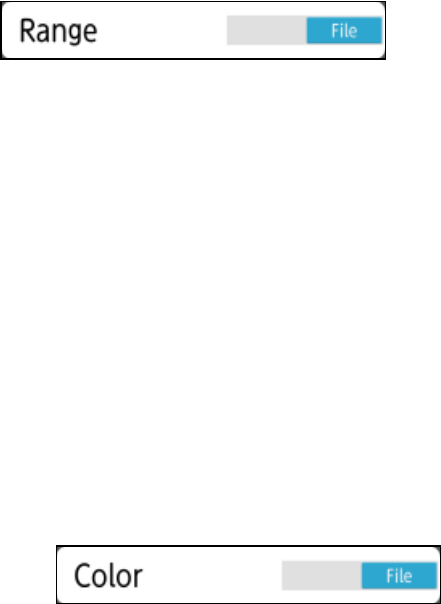
77
4.11.12. Preferred setting: [Range] menu
Preferred setting: [View range] menu (Figure 4-40) in the parameter setup screen (Figure
4-21) allows you to specify which view range setting of the file or device setting is used to
display the scan result image when recalling the scan result from the file. The menu shows
the current setting at the right hand. Figure 4-40 shows the case of the current setting: File.
Figure 4-40 Preferred setting: [View range] menu
The available settings are below.
Device: uses Device setting: View range setting to display the scan image.
File: uses the view range setting recalled from the file to display the scan image.
You can change the setting with the following procedure.
(1) Tap Preferred setting: [View range] menu. Then the setting alternates between
Device and File.
(2) Confirm the selected setting is shown as the current setting in the menu.
(3) Tap [Return to the main window] to return to the main screen.
4.11.13. Preferred setting: [Color] menu
Preferred setting: [Color] menu (Figure 4-41) in the parameter setup screen (Figure 4-21)
allows you to specify which display color setting of the file or device setting is used to
display the scan result image when recalling the scan result data from the file. The menu
shows the current setting at the right hand. Figure 4-41 shows the case of the current
setting: File.
Figure 4-41 Preferred setting: [Color] menu
The available settings are below.
Device: uses Device setting: Display color setting to display the scan image.
File: uses the display color setting recalled from the file to display the scan image.
You can change the setting with the following procedure.
(1) Tap Preferred setting: [Color] menu. Then the setting alternates between Device and
File.
(2) Confirm the selected setting is shown as the current setting in the menu.
(3) Tap [Return to the main window] to return to the main screen.

78
4.11.14. Preferred setting: [Unit] menu
Preferred setting: [Unit] menu (Figure 4-42) in the parameter setup screen (Figure 4-21)
allows you to specify which unit setting of the file or device setting is used to display the
scan result image when recalling the scan result from the file. The menu shows the
current setting at the right hand. Figure 4-42 shows the case of the current setting: File.
Figure 4-42 Preferred setting: [Unit menu] menu
The available settings are below.
Device: uses Device setting: Unit setting to display the scan image.
File: uses the unit setting recalled from the file to display the scan image.
You can change the setting with the following procedure.
(1) Tap Preferred setting: [Unit] menu. Then the setting alternates between Device and
File.
(2) Confirm the selected setting is shown as the current setting in the menu.
(3) Tap [Retrun to the main window] to return to the main screen.
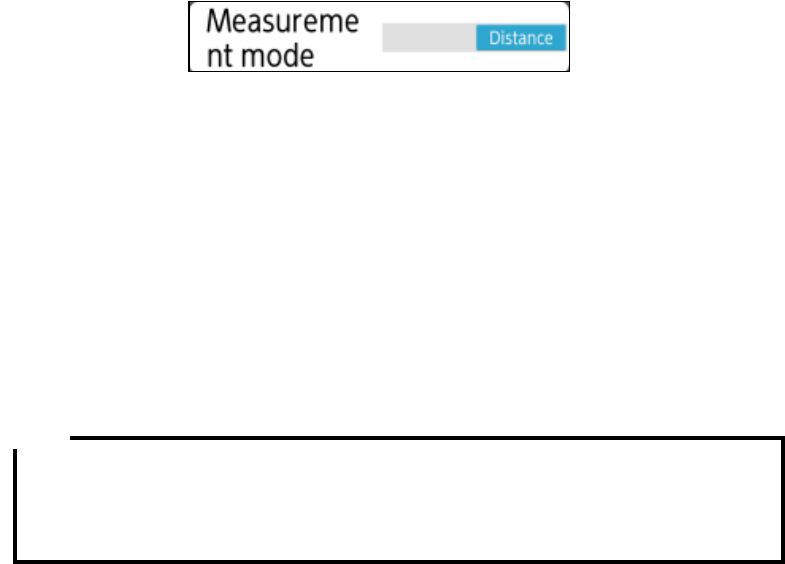
79
4.11.15. Sensor setting: [Measurement mode] menu
Sensor setting: [Measurement mode] menu (Figure 4-43) in the parameter setup screen
(Figure 4-21) allows you to set the measurement mode to Distance or Time. The menu
shows the current setting at the right hand. Figure 4-43 shows the case of the current
setting: Distance.
Figure 4-43 Sensor setting: [Measurement mode] menu
The available settings are below.
Distance: performs a scan per every 2.5 mm movement of the sensor unit and displays
the image on the distance scale.
Time: performs a scan every 50 ms and displays the image on the time scale.
You can change the setting with the following procedure.
(1) Tap Sensor setting: [Measurement mode] menu. Then the setting alternates
between Distance and Time.
(2) Confirm the selected setting is shown as the current setting in the menu.
(3) Tap [Return to the main window] to return to the main screen.
y .測定方式設定:時間送りは、探査開始後にセンサー本体のスタートボタンを約 8
秒はなすと自動的に探査を終了します。探査を継続するには、センサー本体のス
タートボタンを押し続けてください。探査終了はスマートフォンのスタートアイ
コンをタップもしくはセンサー本体のマーカボタンを長押ししてください。
Note
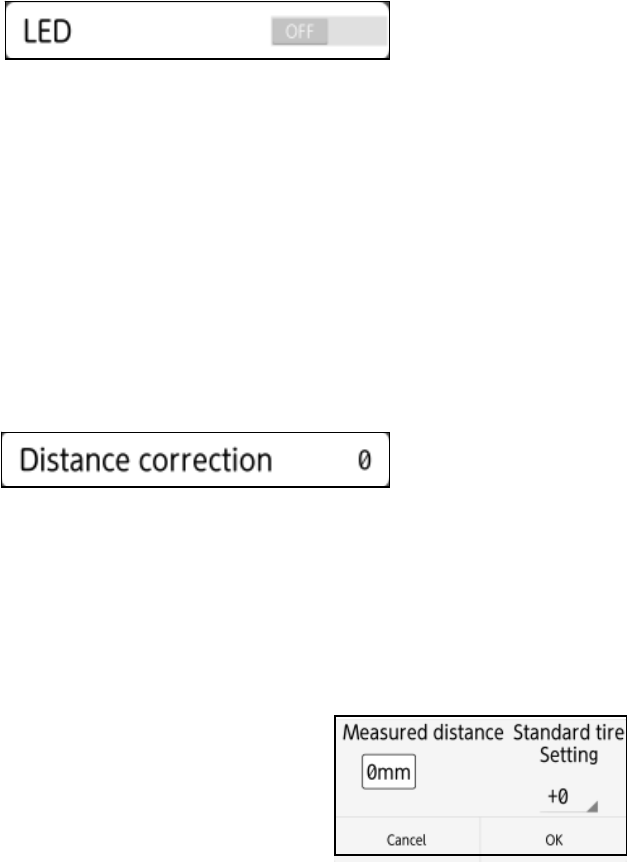
80
4.11.16. Sensor setting: [LED] menu
Sensor setting: [LED] menu (Figure 4-44) in the parameter setup screen (Figure 4-21)
allows you to set LEDs of the senor unit to on and off. (For the location of LED on the
sensor unit, refer to Figure 1-2 ⑪、⑫、⑰ and ⑱). The menu shows the current setting
at the right hand. Figure 4-44 shows the case of the current setting: ON.
Figure 4-44 Sensor setting: [LED] menu
The available settings are ON (turn on) and OFF (turn off). You can change the setting with
the following procedure.
(1) Tap Sensor setting: [LED] menu. Then the setting alternates between ON and OFF.
(2) Confirm the selected setting is shown as the current setting in the menu.
(3) Tap [Return to the main window] to return to the main screen.
4.11.17. Sensor setting: [Distance correction] menu
Sensor setting: [Distance correction] menu (Figure 4-45) in the parameter setup screen
(Figure 4-21) allows you to correct the distance error caused by the tire wear of the sensor
unit. For the details of the distance correction, refer to Section 6.8 Distance error correction.
The menu shows the current setting at the right hand. Figure 4-45 shows the case of the
current setting: 0.
Figure 4-45 Sensor setting: [Distance correction] menu
The available setting range is from -20 to +20. You can change the setting with the
following procedure.
(1) Tap Sensor setting: [Distance correction] menu. Then the distance correction
screen (Figure 4-46) appears and shows the current setting.
(2) Tap the current setting (+0 in Figure 4-46), then the list of available correction values
appears.
(3) Scroll the list and tap the desired correction value.
(4) Confirm the selected setting is shown as the
current setting in the screen.
(5) Tap [OK] to return to the parameter setup screen.
To cancel the setting change, tap [Cancel], then
the screen returns to the parameter setup screen
without setting change.
(6) Tap [Return to the main window] to return to the
main screen.
Figure 4-46 Distance correction screen
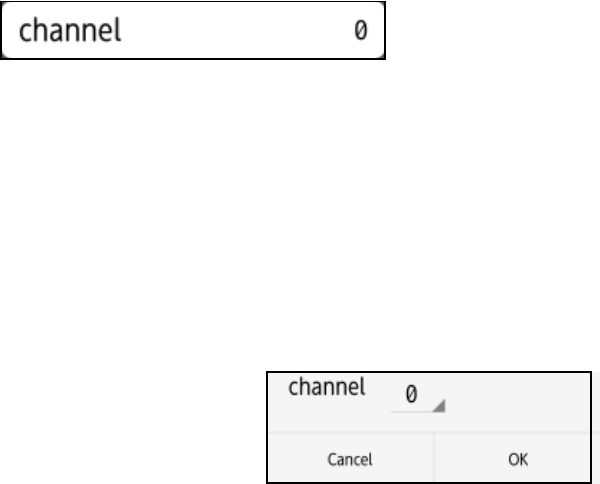
81
4.11.18. Sensor setting: [Channel] menu
Sensor setting: [Channel] menu (Figure 4-47) in the parameter setup screen (Figure 4-21)
allows you to set the channel used for the WiFi communication between Smartphone and
the sensor unit. For the details of the channel setting procedure, refer to
Section 6.7 Communication channel setup. The menu shows the current setting at the
right hand. Figure 4-47 shows the case of the current setting: 0.
Figure 4-47 Sensor setting: Channel menu
The available settings are range is from 0 to 11.
You can change the setting with the following procedure.
(1) Tap Sensor setting: [Channel] menu. Then the channel setup screen (Figure 4-48)
appears and shows the current setting.
(2) Tap the channel setting value (0 in Figure 4-48), then the list of available channels
appears.
(3) Scroll the list and tap the desired channel.
(4) Confirm the selected setting is shown as the current setting in the screen.
(5) Tap [OK] to return to the parameter setup
screen. To cancel the setting change, tap
[CANCEL]. Then the screen returns to the
parameter setup screen without setting
change.
(6) Tap [Return to the main window] to return
to the main screen.
Figure 4-48 Channel setup screen
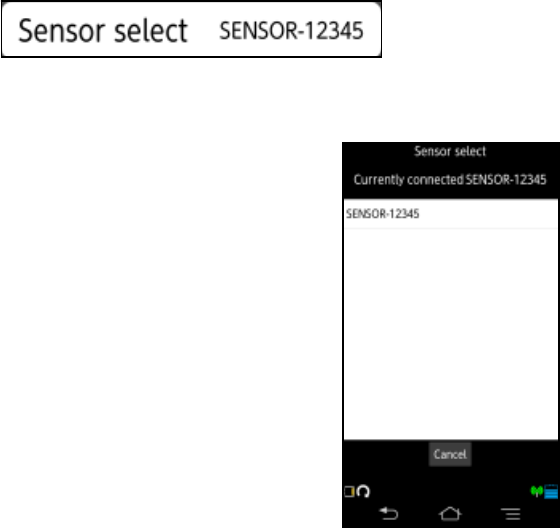
82
4.11.19. Other: [Sensor select] menu
Other: [Sensor select] menu (Figure 4-49) in the parameter setup screen (Figure 4-21)
allows you to select a sensor unit for which the Smartphone establishes the WiFi
communication. For more details, refer to Section 6.7 Communication channel setup. The
menu shows the current setting at the right hand. Figure 4-49 shows the case of the
sensor unit SENSOR-12345 connected.
Figure 4-49 Other: [Sensor select] menu
You can change the setting with the following procedure.
(1) Tap Other: [Sensor select] menu. Then the
sensor select screen (Figure 4-50) appears and
shows the current setting and lists SSIDs of
available sensor units which is located near and
detected by Smartphone.
(2) Tap a SSID to establish the communication with
Smartphone. Then the screen returns to the main
screen. And Smartphone establish the
communication with the selected sensor unit. The
color of the antenna mark shown at the right
bottom of the main screen changes from Red to
Greed after the communication established.
(3) In step (2), tap [Cancel] to cancel the setting
change, then the screen returns to the parameter
setup screen without setting change.
(4) Tap [Return to the main window] to return to the
main screen.
Figure 4-50 Sensor select screen
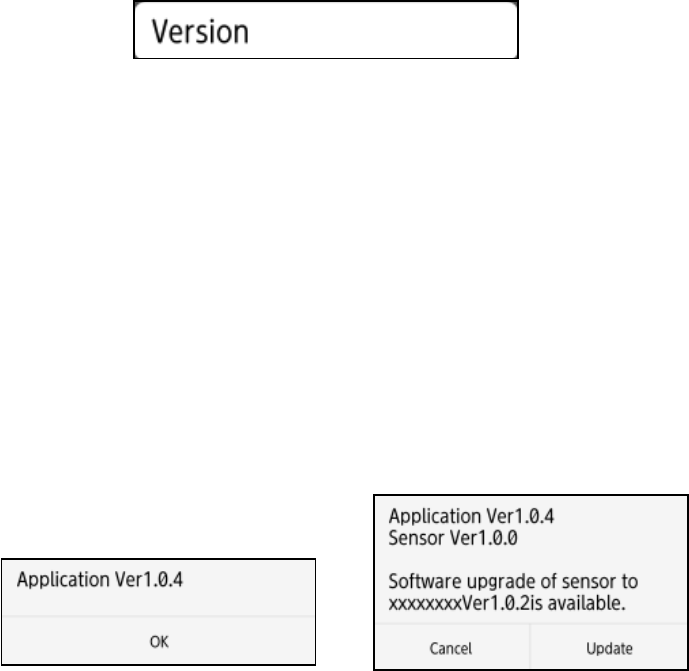
83
4.11.20. Other: [Version] menu
Other: [Version] menu (Figure 4-51) in the parameter setup screen (Figure 4-21) allows
you to show the version information of NJJ-200 application and the firmware of the sensor
unit and to update the firmware of the sensor unit.
Figure 4-51 Version menu
To confirm the software version, tap Other: [Verson] menu. Then the version screen
shown as Figure 4-52 appears.
When the communication is not established between Smartphone and the sensor unit, the
screen shown as Figure 4-52 1) appears and shows only the version of NJJ-200
application.
When the communication has been established between Smartphone and the sensor unit,
the screen shown as Figure 4-52 2) appears and shows both of the version of NJJ-200
application and the firmware version of the sensor unit. To update the firmware of the
sensor unit, tap [Update]. To cancel the update, tap [Cancel], then the screen returns to
the parameter setup screen.
For the procedure to update the firmware of the sensor, refer to Section 6.9.2 Software
version up for Sensor unit.
1) No communication with the sensor 2) Active communication with the sensor
Figure 4-52 Version display screen
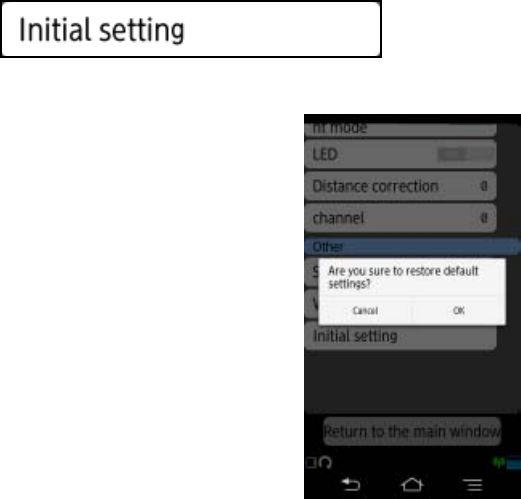
84
4.11.21. Other: [Initial setting] menu
Other: [Initil setting] menu (Figure 4-53) in the parameter setup screen (Figure 4-21)
allows you to restore the initial values (settings at the factory shipment) to all settings.
Figure 4-53 Other: [Initial setting] menu
You can restore the initial settings with the following
procedure.
(1) Tap Other: [Initial setting] menu. Then the initial
setting conformation screen (Figure 4-54) appears.
(2) Tap [OK], then the initial setting are restored to all
settings, then the screen returns to the parameter
setup screen. To cancel the initialization, tap
[Cancel], then the screen returns to the parameter
setup screen without restoring the initial values.
Figure 4-54 Initial setting confirmation
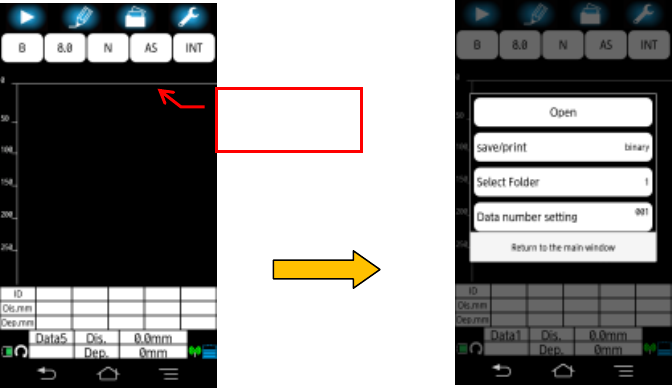
85
4.12. File operation screen
File operation screen (Figure 4-55) allows you to perform several file operations:
saving/recalling the scan result data to/from the file, the folder setup, and the data number
setup. You can access the file operation screen by long tapping the [File/Print] icon. This
section describes file operations available in the file operation screen.
Figure 4-55 File operation screen
)
Ling tap the
File/Print icon
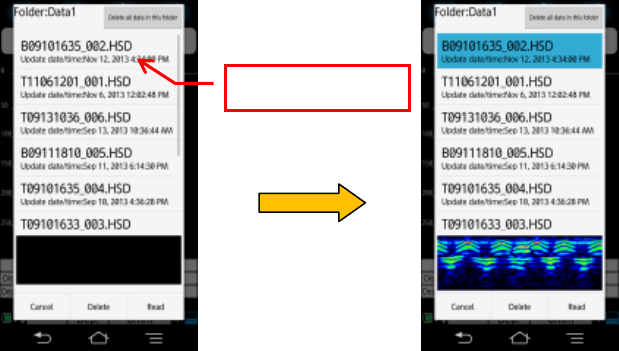
86
4.12.1. [Open] menu
[Open] menu shown in File operation screen (Figure 4-55) allows you to show the list of
the scan result files stored in Smartphone, to read the scan result data from the file, and to
delete the selected file. Tap [Open] menu, then the file list screen as shown in Figure 4-56
appears.
To read the data from the selected file, perform the following steps.
(1) Tap the desired file. Then the background of the tapped file become blue and the
thumbnail of the selected file is shown at the bottom of the screen.
(2) Tap [Read], then the data are read from the file and are shown on the main screen.
To delete the selected file, perform the following steps.
(1) Tap the desired file. Then the background of the tapped file become blue and the
thumbnail of the selected file is shown at the bottom of the screen.
(2) Tap [Delete], then a message “Delete confirmation?” appears.
(3) Tap [OK], then the file is deleted and the screen returns to the file list screen. To
cancel the file deletion, tap [Cancel], then the screen returns to the file list screen.
To delete all files in a folder, perform the following steps.
(1) tap Delete all data in this folder at the right upper side on the file list screen. Then a
message Delete confirmation? appears.
(2) Tap OK, the the file is deleted and the screen is return to the file list screen. Tap
[Cancel] to cancel to delete all files, then the screen returns to the file list screen.
You can return to the main screen by tapping [Cancel] in the file list screen. For the details
of File open screen, refer to Sections from 5.3 and 5.7.
Figure 4-56 File open screen
)
Tap a file name.
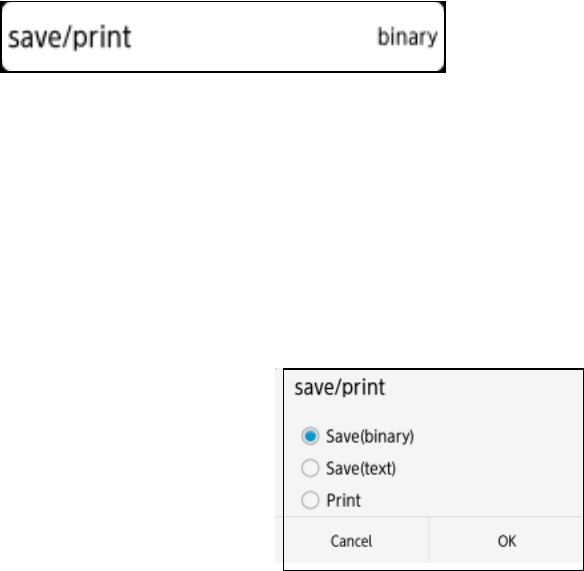
87
4.12.2. [save/print] menu
[save/print] menu (Figure 4-57) in the file operation screen (Figure 4-55) allows you to
select the output destination of the scan result data. The menu shows the current setting at
the right hand side. Figure 4-57 shows the case of the current setting: Save (Binary).
Figure 4-57 [Save/Print] menu
The available settings are below.
Save (Binary): outputs the data into the file with the binary formart.
Save (Text): outputs the data into the file with the text format.
Print: outputs the data to the external printer.
You can change the setting with the following procedure.
(1) Tap [Save/Print] menu. Then the file/print setup screen (Figure 4-58) appears. The
mark ● shows the current setting.
(2) Tap a desired setting, and confirm the mark
● is moved to the selected setting.
(3) Tap [OK] to return to the file operation screen.
To cancel the setting change, tap [CANCEL],
then the screen returns to the file operation
screen without setting change.
(4) Tap [Return to the main window] to return
to the main screen.
Figure 4-58 File/Print setup screen
For the details of the file output, refer to Section 5 External output.
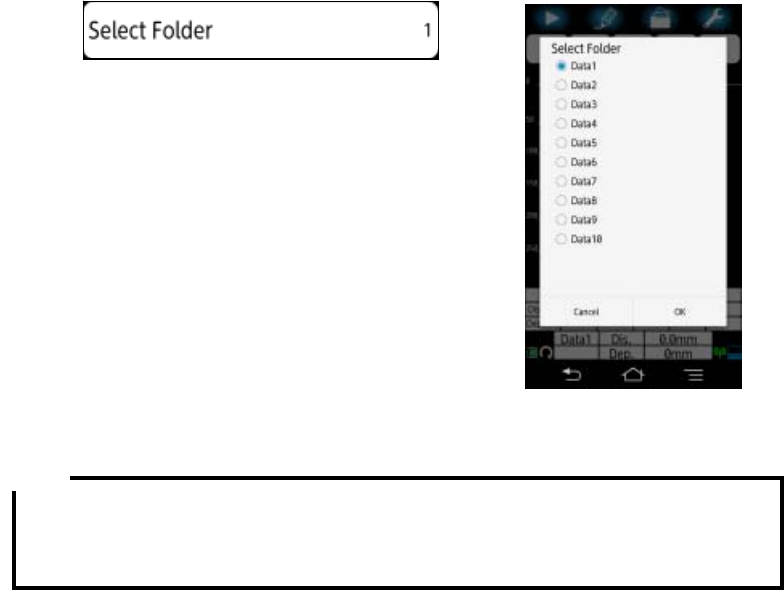
88
4.12.3. [Select Folder] menu
[Select folder] menu (Figure 4-59) in the file operation screen (Figure 4-55) allows you to
select the folder under which the scan data are stored in the memory card of Smartphone.
The menu shows the current setting at the right hand. Figure 4-59 shows the case of the
current setting: Data1.
Figure 4-59 [Select Folder] menu
The available settings are from 1 to 10. You can change
the setting with the following procedure.
(1) Tap [Select folder] menu. Then Select Folder
screen (Figure 4-60) appears. The mark ● shows
the current setting.
(2) Tap a desired setting, and confirm the mark ● is
moved to the selected setting.
(3) Tap [OK] to return to the file operation screen. To
cancel the setting change, tap [Cancel], then the
screen returns to the file operation screen without
setting change.
Figure 4-60 Folder select screen
y The folders from Folder 1 to Folder 10 are automatically created into the memory
card of Smartphone when booting up NJJ-200 application.
y For the procedure to read/save the scan data, refer to Section 5 External output.
Note
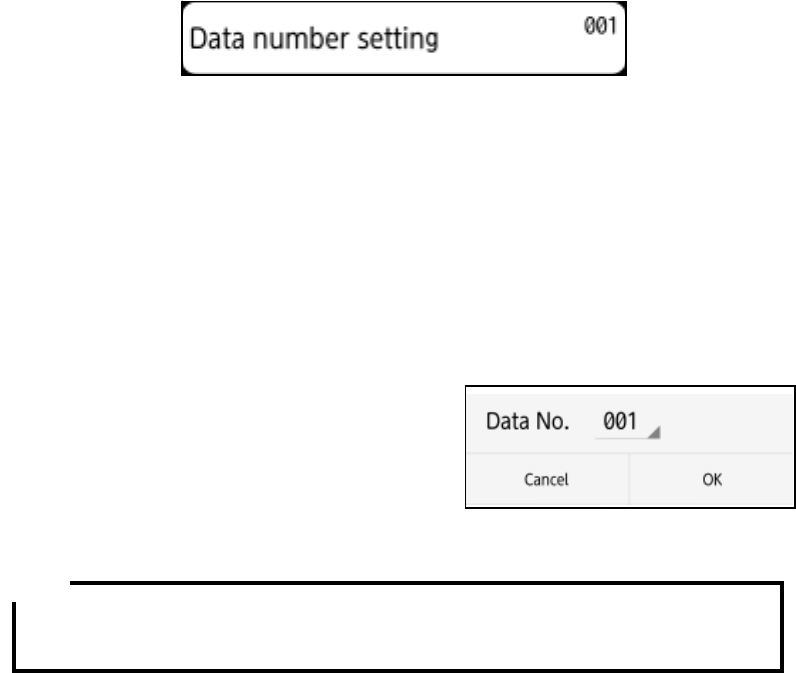
89
4.12.4. [Data number setting] menu
[Data number setting] menu (Figure 4-61) in the file operation screen (Figure 4-55)
allows you to set the data number of the file into which the scan data is stored. The menu
shows the current setting at the right hand side. Figure 4-61 shows the case of the current
setting: Data number 001.
Figure 4-61 Data number menu
The available settings are from 0 to 999. The data number is used as a part part of the file
name and is increased with one every when the data is stored into the file.
You can change the setting with the following procedure.
(1) Tap [Data number setting] menu. Then Data No. screen (Figure 4-62) appears
and shows the current setting.
(2) Tap the current setting (001 in Figure 4-62), then the list of available data numbers
appears.
(3) Scroll the list and tap the desired number.
(4) Confirm the desired channel is shown as the current setting in the Data No. screen.
(5) Tap [OK] to return to the file operation
screen. To cancel the setting change, tap
[Cancel], then the screen returns to the file
operation screen without setting change.
(6) Tap [Return to the main window] to return
to the main screen.
Figure 4-62 Data No. setup screen
y When you want to re-scan the data, changing the data number makes the data
file management easier.
Note
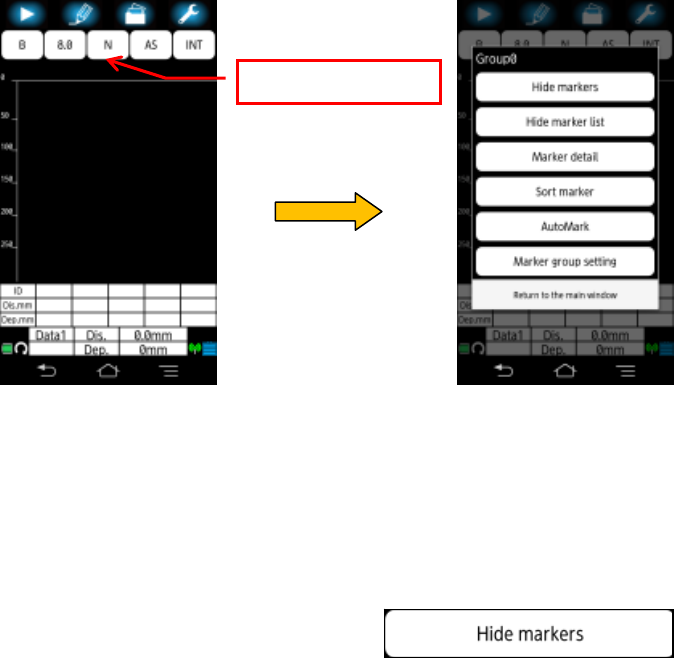
90
4.13. Marker operation
Marker operation screen (Figure 4-63) allows you several marker operations: hide markers,
Show marker list, Marker details, sort marker, AutoMark, and so on. You can access
Marker Operation screen by long tapping the Marker Icon. This section describes
operations available in the marker operation screen.
Figure 4-63 Marker operation screen
4.13.1. [Hide markers] menu
[Hide markers] menu (Figure 4-64) in the marker operation screen (Figure 4-63) allows
you to hide all markers displayed on the scan result image. To hide all markers, tap [Hide
markers] menu. To redisplay hidden markers, tap any position of B mode screen or the
marker list. This function is helpful to see and
confirm the part of the scan result image hidden
by the displayed markers.
Figure 4-64 [Hide markers] menu
)
Long tap [Mark] icon.
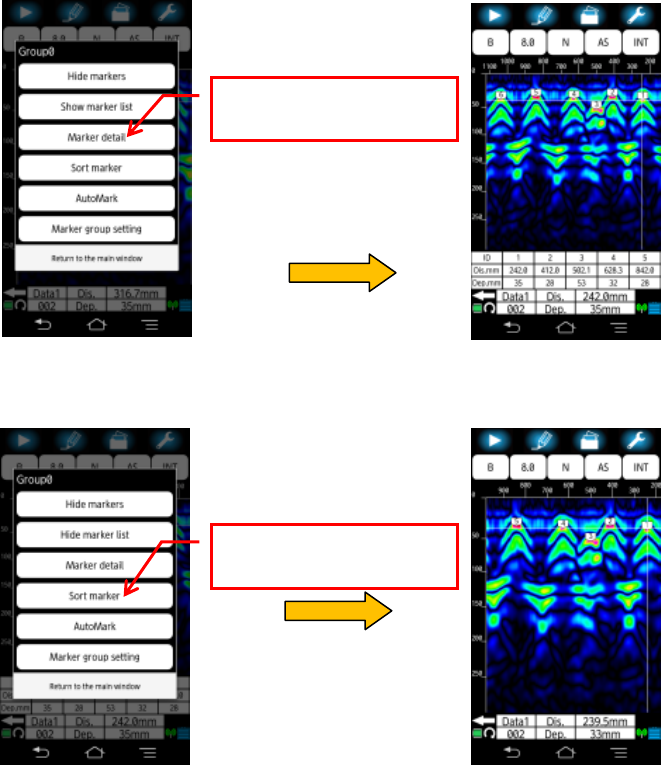
91
4.13.2. [Show marker list] menu
[Show marker list] / [Hide marker list] menu (Figure 4-65) in the marker operation
screen (Figure 4-63) allows you to show/hide the marker list. When you want to see the
scan result in the large screen, hide the marker list. When you want to confirm the
coordinates of markers, show the marker list.
To show the marker list, tap [Show marker list] menu as shown in Figure 4-65 1), then
the screen returns to the main screen. To hide the marker list, tap [Hide marker list] menu,
then the screen returns to the main screen as shown in Figure 4-65 2).
1) Show marker list
2) Hide maker list
Figure 4-65 Show/Hide marker list
)
Tap [Show marker list]
menu.
)
Tap [Hide marker list]
menu.
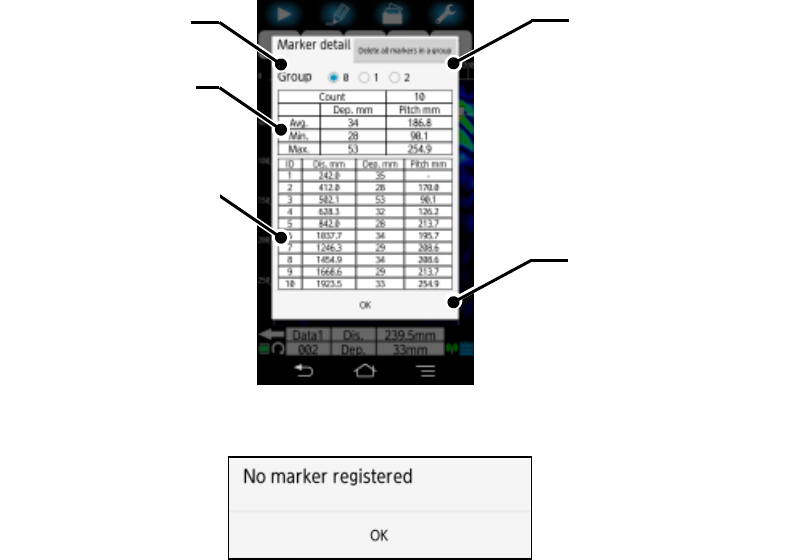
92
4.13.3. [Marker details] menu
[Marker details] menu in the marker operation screen (Figure 4-63) allows you to show
the marker details screen (Figure 4-66) which shows the detailed information (statistic,
distance and depth of each marker, pitch between neighboring markers) of all markers
registered in each marker group.
To show the marker details screen, tap [Marker detail] menu. To return to the main screen,
tap [OK]. When tapping [Marker details] menu when no marker registered, a message
shown in Figure 4-67 appears. In this case, tap [OK] to return to the main screen.
The details of each information on the marker details screen are provided below.
Figure 4-66 Marker details screen
Figure 4-67 Message of no marker
(1) Group selection
(2) Marker statistic
table
(3) Marker
coordinates table
(4)[Delete all markers
in a group] button
(5) [OK] button
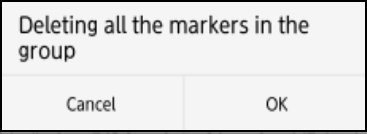
93
(1) Group selection
Group selection allows you to select the marker group to show the detailed information in
the marker details screen. Tap a desired marker group. Then the mark ● is displayed at
the selected marker group, then the detailed information of the selected marker group is
shown in the marker details screen.
(2) Marker statistic table
The marker statistic table shows the number of registered markers, average, minimum and
maximum of depth and pitch (distance between neighboring markers). When only one
marker is registered, “-“ is shown at the pitch.
(3) Marker coordinate table
The marker coordinate table shows the distance and depth of each registered marker and
each pitch between two neighboring markers. The pitch is the absolute distance between
two markers of ID n and ID n+1 (N= 1,2,3…). You can scroll the marker coordinate table
vertically.
(4) [Delete all marker in a group button] button
[Delete all marker in a group] button located at the right upper side of the marker details
screen allows you to delete all markers registered in the selected group. To delete all
markers, tap [Delete all marker in a group] button, then a message “Deleting all the
markers in the group” (Figure 4-68) appears. Tap [OK] to delete all markers. To cancel
to delete the markers, tap [Cancel], then the screen returns to the marker details screen.
Figure 4-68 Delete all markers in group
(5) [OK] button
[OK] button closes the marker details screen. Tap [OK] to return to the main screen.
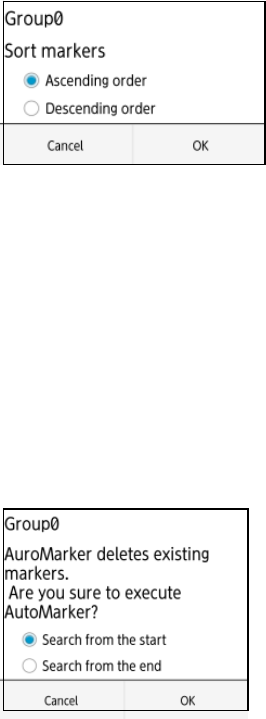
94
4.13.4. [Sort marker] menu
[Sort marker] menu in the marker operation screen (Figure 4-63) allows you to re-number
the ID numbers of the registered markers as ascending or descending order. For more
details of [Sort marker] menu, refer to 6.6 Sort marker. The following sortings are
available.
y Ascending order: renumbers the ID number of markers from the scan start position
(distance 0) to the scan end point.
y Descending order: renumbers the ID numner of Markers from the scan end poistion to
the scan start position.
You can sort the marker ID numbers with the following procedure.
(1) Tap [Sort marker] menu. Then the sort marker screen (Figure 4-69) appears. The
mark ● shows the current setting.
(2) Tap a desired setting, and confirm the mark ● is
attached to the selected setting.
(3) Tap [OK] to sort the ID numbers of markers, then
the screen return to the main screen. To cancel the
sort marker, tap [Cancel], then the screen returns
to the main screen without sorting the marker IDs.
Figure 4-69 Sort marker screen
4.13.5. [AutoMark] menu
[AutoMark] menu in the marker operation screen (Figure 4-63) allows you to execute the
AutoMark function which automatically analyzes the scan data, detects the embedded
object, and adds the marker on the detected object. For more details of AutoMark function,
refer to Section 6.3 AutoMark function. You can specify the direction of the detection
processing: Search from the start or Search from the end.
You can execute the AutoMark function with the following procedure.
(1) Tap [AutoMark] menu. Then AutoMark screen (Figure 4-70) appears. The mark ●
shows the current setting.
(2) Tap a desired setting: [Search from the start] or
[Search from the end], and confirm the mark ●
is attached to the selected setting.
(3) Tap [OK] to execute the AutoMark function, then
the screen return to the main screen. To cancel the
AutoMark function, tap [Cancel], then the screen
returns to the main screen without executing the
AutoMark function.
Figure 4-70 AutoMark screen
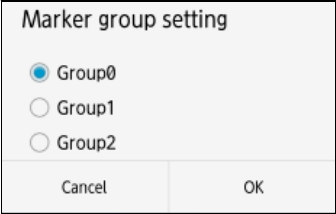
95
4.13.6. [Marker group setting] menu
[Marker group setting] menu in the marker operation screen (Figure 4-63) allows you to
select a marker group into which newly added markers are registered. The available
marker group are Group 0 to 2. The marker IDs of 1 to 99 are allocated to Marker group 0,
the IDs of 101 to 199 to Marker group 1, and the IDs of 201 to 299 to Marker group 2.
You can specify the marker group with the following procedure.
(4) Tap [Marker group setting] menu. Then the marker group setup screen (Figure
4-71) appears. The mark ● shows the
current setting.
(5) Tap a desired setting: [Group 0], [Group
1], or [Group 2], and confirm the mark ●
is attached to the selected setting.
(6) Tap [OK] to return to the main screen. To
cancel the Marker group setting, tap
[Cancel], then the screen returns to the
main screen without changing the Marker
group setting.
Figure 4-71 Marker group setup screen
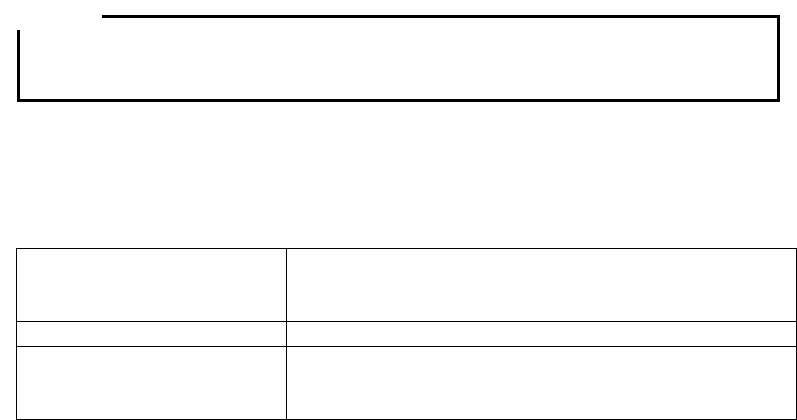
96
5. External output
This product supports two external outputs for the scan result: Save the scan data into the
memory card mounted on Smartphone and print out the image of the main screen to the
external printer (Option). This section describes these two procedures to output the scan
result.
5.1. Save the scan result into the file
This product can store the scan result into the memory card mounted on Smartphone. You
can use binary or text as the data storage format.
y Make sure to turn off the Smartphone before inserting or removing the memory card
from Smartphone.
5.1.1. Binary format
The scan result data of the binary format consists of the following three parts.
Header block (ASCII data)
contains the information of the scan condition
(Date/Time, Scan parameters, Scan data size, and so
on).
Data block(Binary data) contains the data attribute information and scan data.
Marker block contains the information about the markers registered on
the scan data (Marker coordination of distance and
depth).
Caution
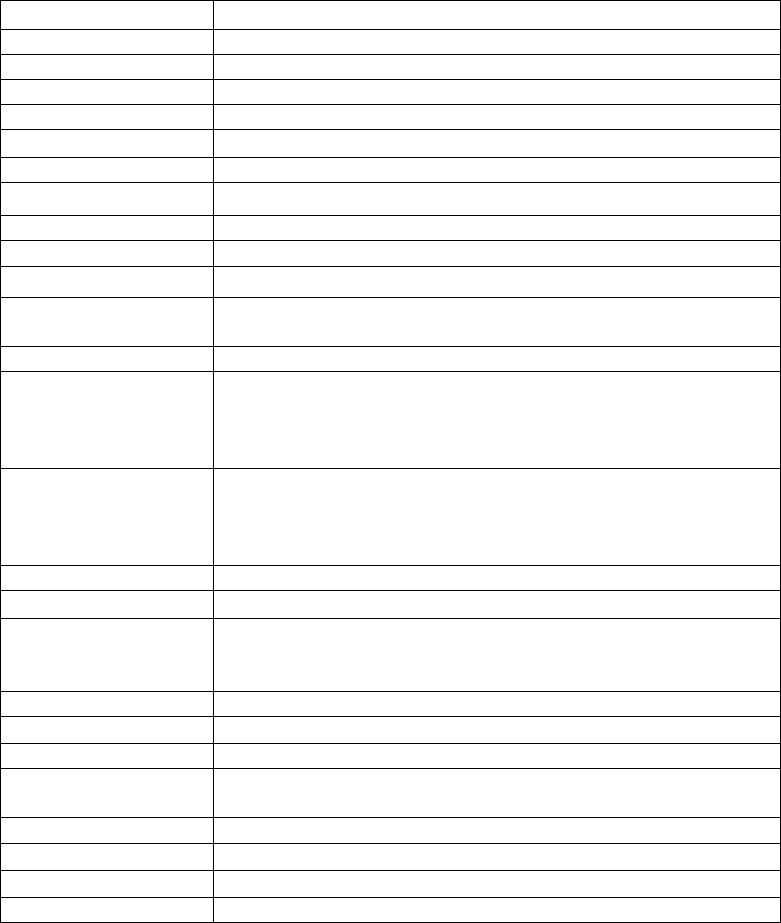
97
(1) Header block (Binary format)
The header block contains the information of the scan condition (Date/Time, Scan
parameters, Scan data size, and so on). Table 5-1 shows the data structure of the header
block and description of each part.
Table 5-1 Header structure
Header block example Description
Model ,NJJ-200 Identifier of the sensor unit
Ser No. ,ED12345 Serial number of the sensor unit
Data ,2013/11/07 Data of the scan execution
Time ,11:23 Time of the scan execution
DataNo ,2 Data number
X Data size ,200 Number of the scan lines
Y Data Size ,768 Number of data points per one line 768 (Fixed)
X Scale ,0 Scan method 0: Distance feed / 1: Time feed
X Adjust ,0 Distance correction setting
Y Scale ,8.0 Relative permittivity setting
Sencitivity ,2 Sensitivity setting 0:-2S / 1:-1S / 2:AS / 3:+1S / 4:+2S / 5:-2D / 6:-1D /
7:AD / 8:+1D / 9:+2D
ViewRange ,1 Display setting 0:S / 1:N / 2:D / 3:SW / 4:NW / 5:DW
Processing ,0
Image processing setting 0: Fixed surface wave processing / 1: Average
processing / 2: Subtraction processing /
3: Manual surface wave processing / 4: User surface wave processing / 5:
Original image
Prcs as MS ,0
Image processing (Reserved) 0: Fixed surface wave processing / 1:
Average processing / 2: Subtraction processing /
3: Manual surface wave processing / 4: User surface wave processing / 5:
Original image
Processing Line ,0 Subtraction processing line 0: None / 1 to 6000: Processing line number
Peak ,0 Peak processing setting 0: OFF / 1: ON
Color ,0
Display color setting 0: Color 1 Abs / 1: Color 2 Abs / 2: Color 3 Abs / 3:
Monochrome 1 Abs / 4: Monochrome 2 Abs / 5: Color 1 Offset / 6: Color 2
Offset / 7: Color 3 Offset / 8: Nonchrome 1 Offset / 9: Monochrome 2 Offset
Tire Op ,0 Reserved 0(Fixed)
Handle ,1 Operational direction setting 0: Right / 1: Left
Direction , 0 Moving direction setting 0: Forward / 1: Backward
X Pitch ,2.5 Distance measurement pitch setting 2.5 (this varies with the distance
correction value.)
XUnit ,0 Distance unit setting 0: mm / 1: cm / 2: m / 3: inch
YUnit ,0 Depth unit setting 0: mm / 1: cm / 2: m / 3: inch / 4: nsec
Marks ,0 Number of markers 0 to 296
END,0 End mark of the header block
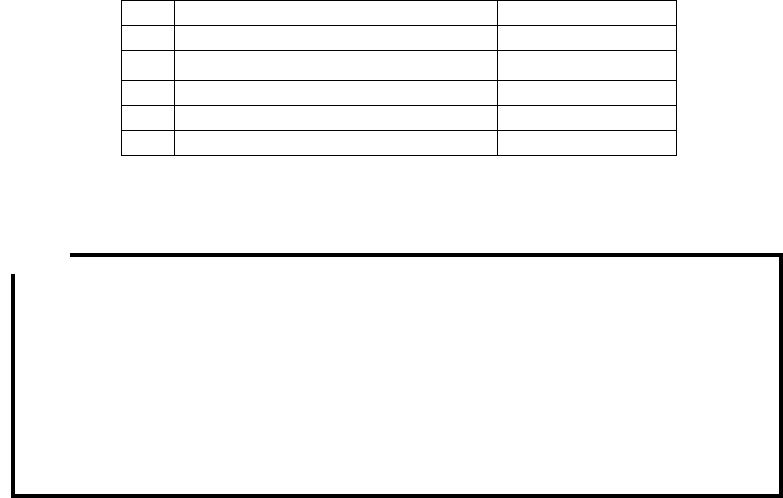
98
(2) Data block (Binary format)
The data block contains the data attribute information and scan data. The data block
consists of several line data. Each line data consists of the line header and scan data as
shown below. The scan data has a fixed data length of 768 points.
Line header 1 point + Scan data 768 points =769 points
The line header indicates the attribute of each line data. Table 5-2 shows the attribute
indicated by each line header code.
Table 5-2 Line header attribute
No. Data name Line header code
1 Fixed surface wave data -1
2 User surface wave data -2
3 Subtraction line data -3
4 Scan data 0
5 Scan data with an antenna marker 1
Each scan data is the 16 bit AD conversion value of the amplitude (voltage value) of the
received signal and has an integer value from -32768 to +32767.
y The data of the binary format has the data size smaller than that of the text format
and can save the memory capacity of Smartphone memory card.
y The data stored into the memory card is the original raw data (Original image) of
the received signal by the sensor unit, but not the data after the image processing.
To replicate the image processed scan image on the PC by using the raw data
read from the data file, you need to generate the image processed image data by
applying the image processing specified by the header information and the line
header to the raw data.
(3) Marker block (Binary format)
The marker block contains the information about the markers registered on the scan data
(Marker coordination of distance and depth). It consists of the following parts.
Marker ID number, Line number, Depth point
When no marker is registered in the scan data, the scan data has no marker block.
Note

99
5.1.2. Text format
The data structure of the text format is same as that of the binary format. The difference
from the binary format is that all data is represented by using ASCII code.
(1) Header block
The header block structure of the text format is same as that of the binary format. For the
details of the header structure, refer to Section 5.1.1 (1) Header block (Binary format).
(2) Data block
The data block structure of the text format is same as that of the binary format. The
difference is that each data is represented by ASCII code in place of the binary data and
the terminator [0x0D][0x0A](CR,LF) is added at the end of each data point. For the details
of the data block structure, refer to Section 5.1.1 (2) Data block (Binary format).
Note
y The data of the binary format has the data size smaller than that of the text format
and can save the memory capacity of Smartphone memory card.
y The data stored into the memory card is the original raw data (Original image) of
the received signal by the sensor unit, but not the data after the image processing.
(3) Marker block
The marker block structure of the text format is same as that of the binary format. For the
marker block structure, refer to Section 5.1.1 (3) Marker block (Binary format).
Note
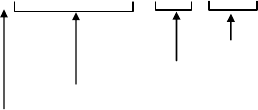
100
5.2. Saving the scan data
This section describes the procedure to save the scan data into the memory card mounted
on Smartphone.
(1) Set the data format of saving the scan data
Long tap [File/Print] icon. Then the file operation screen appears. Tap [Save/Print] menu.
Then the save/print screen appears. Tap [Binary] or [Text] to select the data format.
For more details, refer to Section 4.12.2 [save/print] menu.
(2) Set the folder to which the scan data file is saved
Long tap [File/Print] icon, tap [Select Folder] menu, then tap one of [Data1] to [Data10]
to select a data folder. For more details, refer to Section 4.12.3 [Select Folder] menu.
(3) Set the data number
Long tap [File/Print] icon, tap [Data number setting] menu, then tap the displayed data
number, then scroll the list of the data number and tap the desired data number. The data
number is incremented each time when a scan data is saved into the file.
For more details, refer to Section 4.12.4 [Data number setting] menu.
(4) Save the scan data
Tap [File/Print] icon after completing a scan. Then the scan data is saved into the file
under the folder specified in Step (2) above which is located under the folder “NJJ-200” in
the memory card of Smartphone. The file of the scan data is named automatically as
described below.
B01011345_001.HSD
File extension for the data file of Handysearch
Data number
Date/Time of scan execution
Data format: Binary format: [B], Text format : [T]
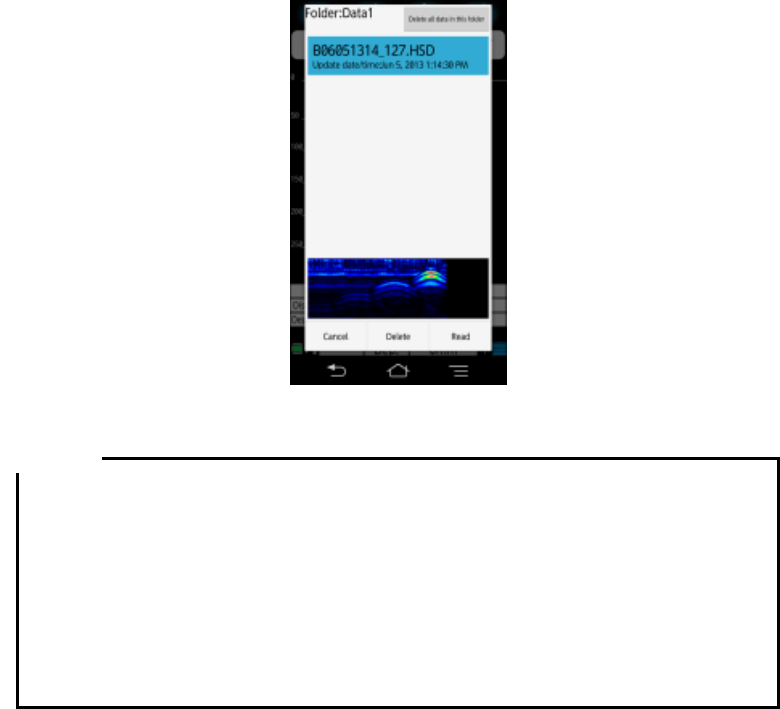
101
(5) Confirm the saved scan data
Long tap [File/Print] icon, tap [Open] menu, then tap the file name to which the scan data
is saved. Then the thumbnail image of the selected scan data file is shown at the bottom of
the screen. By checking the thumbnail image, confirm that the scan data is saved correctly.
For more details, refer to Sections 5.4 to 5.7.
Figure 5-1 Confirmation of the saved data
y When attempting to save data to a remaining memory capacity less than 2
Mbytes, a message “Saving not possible”[OK] appears, and the data saving is
canceled. In this case, delete the unnecessary files or mount the memory card
with the remained capacity more than 2 Mbytes, then perform the data saving.
y The maximum number of the files stored under one folder is 21800 each. When
attempting to save data beyond the maximum number of the files, a message
“Data saving not possible” appears and the data saving is cancelled. In this
case, delete the unnecessary files, then try to save the data again..
)
Caution
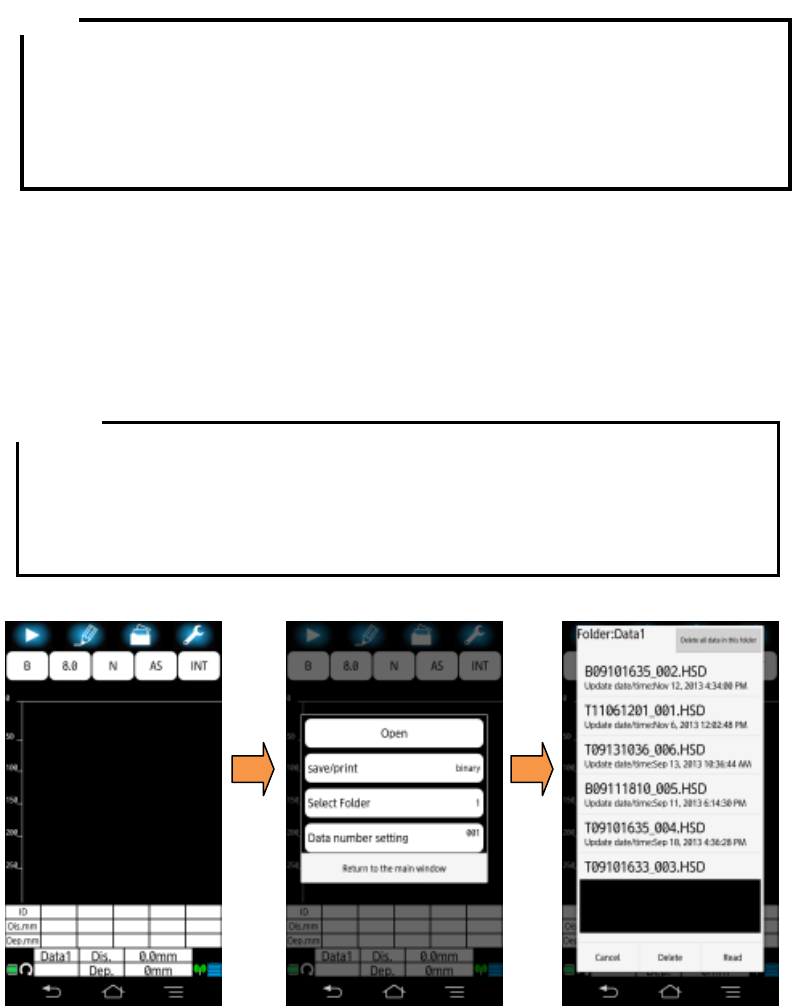
102
y This product has no limitation of the scan distance. The scan data shown on
Smartphone screen and saved into the file is maximum 15 m of the latest scan
data from the scan stop point.
y The scan data saved into the memory card contains the scan conditions displayed
on the screen when performing the data save.
5.3. Data file operation
You can perform data file operations: displaying the thumbnail image of the data file,
reading the scan result from the data file, and deleting the data file by using the file open
screen shown in Figure 5-2. To access the file open screen, long tap the [File/Print] icon
and [Open] menu. This section describes each procedure of data file operations.
y When a lot of files are saved into the current folder, it may take a lot of time to
access to the screen to open the file. During this time, “Creating file
list・・・”[Cancel] appears. (The transient time depends on the memory card
performance and will be around 1 minute for the folder having 1000 pieces of files
and 7 minutes for the folder having 21844 files.)
Figure 5-2 File open screen
)
)
Note
Caution
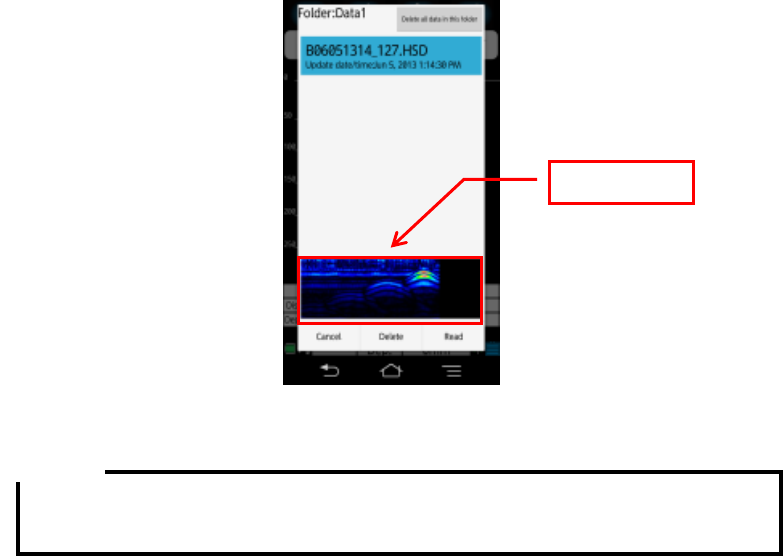
103
5.4. Displaying thumbnail image of the data file
You can display the thumbnail image of the data file by tapping the file name on the file
open screen. After tapping a file name, the background color of the tapped file name
changes to blue. Then the thumbnail image of the scan data saved in the selected file
appears at the bottom of the screen. By using the thumbnail image, you can quickly
confirm that the scan result is saved correctly or confirm that it is what you would like to
read. The color of the thumbnail image is decided by the settings of Sections 4.5.1 [Color]
menu and 4.11.5 Device setting: [Color] menu.
Figure 5-3 Thumbnail image of the save scan data
y The thumbnail image shows a part of the scan data image. (Distance: 1 m, Depth:
Normal, Image processing: Fixed surface wave processing.
Thumbnail
)
Caution
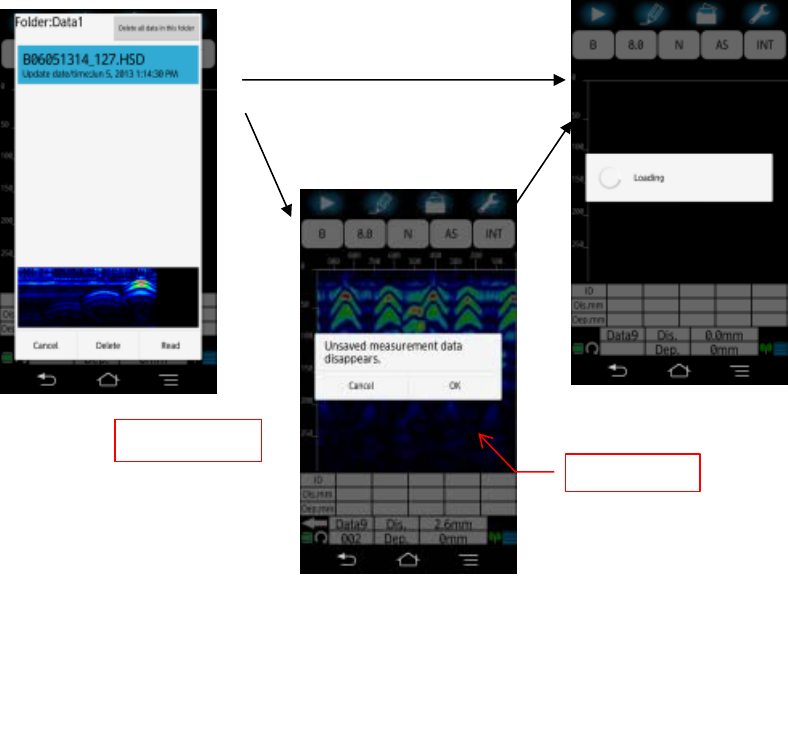
104
5.5. Reading the scan data from the data file
You can read the scan data from the data file with the following procedure.
(1) Tap a file name on the file open screen. Then the background color of the tapped file
name changes to blue. And the thumbnail image of the scan data in the selected file
appears at the bottom of the screen.
(2) Tap [Read] button to read the scan data from the file. Then a message “Reading the
data from the file….” appears. When the message disappears, the data reading
ends. To cancel the data reading, tap [Cancel], then the screen returns to the main
screen without reading the data from the file.
(3) In the step 2, if the scan data displayed on the main screen has not been saved yet
into the file, a message “Measurement data not saved disappears.” To continue
the data reading, tap [OK], then the screen returns to the main screen. To cancel the
data reading, tap [Cancel], then the screen returns to the File open screen.
(Refer to
Figure 5-4.)
Figure 5-4 Reading the scan data from the file
When the scan result on the
main screen has not been
saved.
When the scan result on the
main screen has been saved.
)
Tap [Read].
Tap [OK].
)
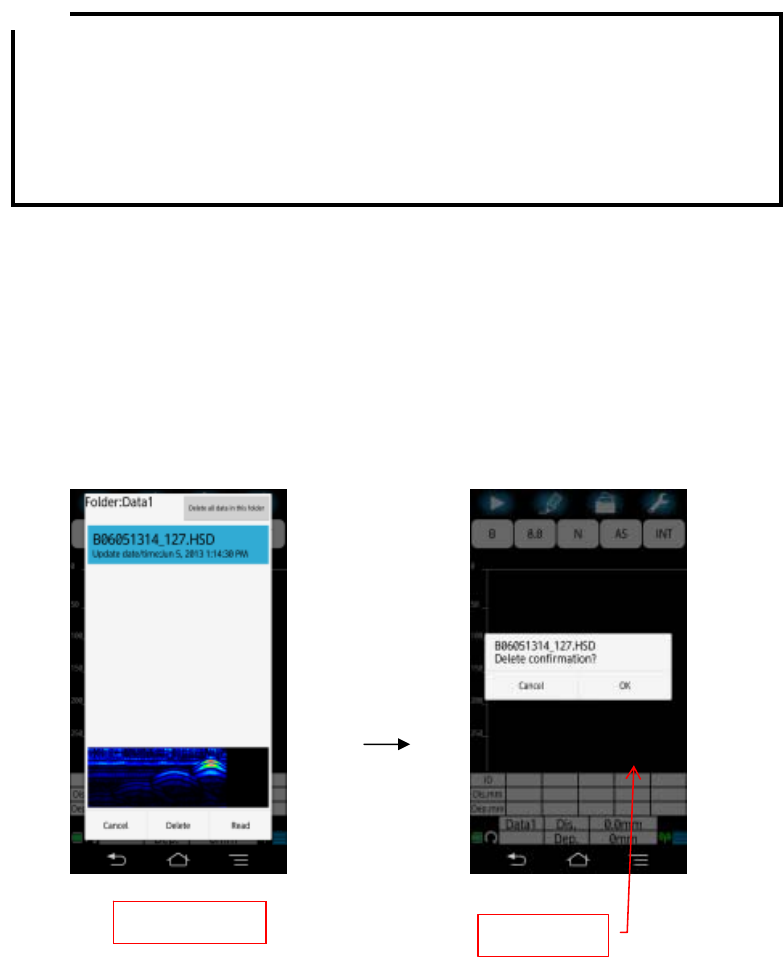
105
The scan data read from the file is displayed by using either of the settings read from the
file or the settings of the sensor unit. For the settings used to display the scan data read
from the file, refer to Sections 4.11.11 Preferred setting: [Sensitivity] menu
to 4.11.14 Preferred setting: [Unit] menu.
y On the fIle open screen, when tapping [Read] without tapping a file, a message
“File not selected.” In this case, tap [OK] to return to the File open screen.
y You can register the user surface wave data in the scan data read from the file.
When you do this, the user surface wave data is memorized in the sensor unit
and is applied to the next scanning. For the procedure to register the user surface
wave, refer to Section 4.10.3 User surface processing.
5.6. Deleting the data file
You can delete data files with the following procedure.
(1) Tap a file name on the File open screen. Then the background color of the tapped file
name changes to blue.
(2) Tap [Delete]. Then a message “Delete confirmation? [OK] [CANCEL]” appears.
Then tap [OK] to continue to delete the file, then the screen returns to the File open
screen. To cancel to delete the file, tap [Cancel], then the screen returns to the File
open screen.
Figure 5-5 Deleting the data file
)
Tap [Delete].
)
Tap [OK].
Note
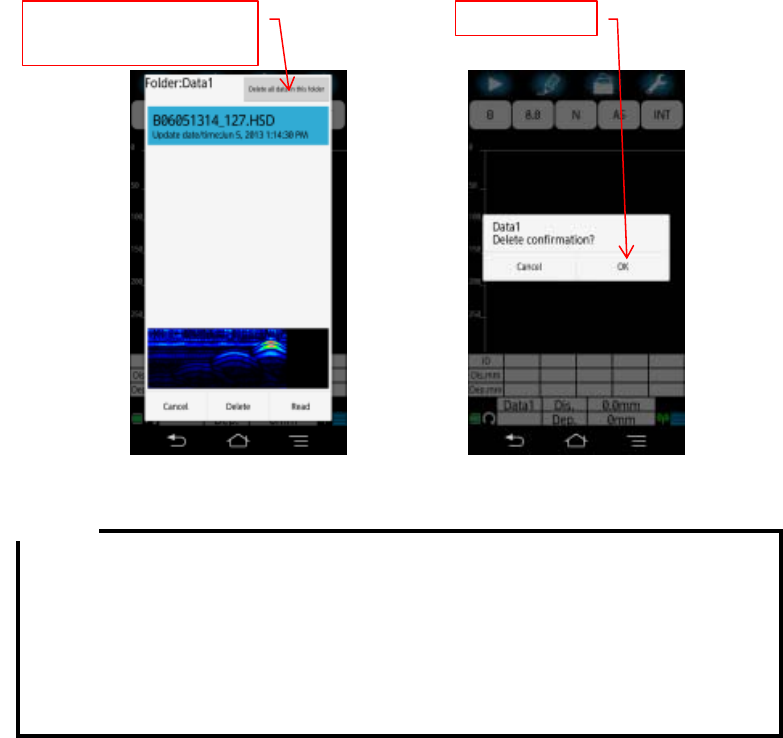
106
5.7. Delete all files under the folder
You can delete all data files with the following procedure.
(3) Tap [Delete all data in this folder] on the file open screen. Then a message “Datax:
Delete confirmation? [CANCEL] [OK]” appears.
(4) Tap [OK] to continue to delete all files, then the screen returns to the file operation
screen. To cancel to delete all files, tap [Cancel], then the screen returns to the file
open screen.
Figure 5-6 Deleting all file under a folder
y Tapping [Delete all data in this folder] deletes all files under the folder.
y When you check the file list on the Smartphone by connecting the PC and
Smartphone in MTP mode after you deleted a file, you may see the deleted file on
the PC screen due to the cached data on the memory of Smartphone. In this case,
clear all cached data of Smartphone (An example of Smartphone operation: Tap
[Settings], [Device settings], [Storage], [Cached data], and [OK]) or connect
Smartphone to the PC in the card reader mode.
)
Tap [Delete all data in
this folder].
)
Tap [OK].
Caution
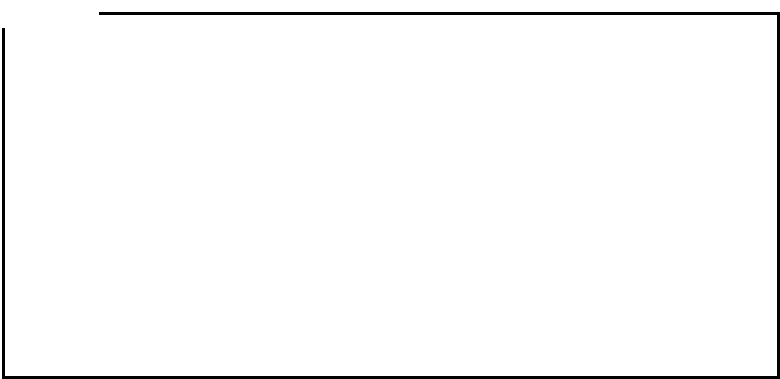
107
5.8. Printer output
You can print out the scan data to the external printer (Option) by connecting the external
printer to Smartphone via Bluetooth communication. To get Bluetooth communication
between the printer and Smartphone, you need to perform the settings for both before
running NJJ-200 application. This section describes the procedure of these settings and
printing the scan data to the printer.
y Cautions on Bluetooth communication
y Some devices operate using the same frequency bands adopted by this product.
Equipment such as microwave ovens and other home electronics, radios and
equipment used in various types of radio stations including Amateur Radio
stations, and devices that operate on industrial, scientific, or medical frequency
bands may experience interference from this product.
1. In case any harmful radio interference occurred, immediately stop to use this
product. Then contact to one of our contact points described in Section 14 or
the distributor from which you purchased this product to get consultation about
the solution.
2. For the other unclear points, contact to our contact points described in
Section 14 or the distributor from which you purchased this product to get
consultation about the solution.
5.8.1. Preparation for the printer
You need to configure software switch setting inside the printer to connect it to Smartphone
via Bluetooth communication. The procedure of the switch configuration is described
below.
(1) Boot up the printer in the menu setting mode and print out the current setup
Set the paper to the printer, keep pushing the [MENU] button down, and turn on the printer.
Here the ERROR LED turns on. Then wait for ERROR LED to turn off , then release the
[MENU] button. The printer starts the printing after POWER LED and STATUS LED light
changes to green. Then press [FEED] (NO) button, as printing the printer setup is not
required.
PD-24 menu printer setup print out
YES:MENU button NO:FEED button EXIT:MENU+FEED button
Do you print out the printer setup?
YES (M) NO (F)
Caution
108
(2) Printer initialization: No
The following message is printed out. Press [FEED] button, because no initialization is
required.
Do you initialize the printer?
Press YES for three seconds.
YES (M) NO(F)
(3) Printer setup change: Do
The following message is printed out. Press [MENU] (YES) button to execute the setup
change.
Do you change the printer setup?
YES(M) NO(F)
(4) Printer setup change: No
The following message is printed out. Press [FEED] (NO) button, because no printer setup
change is required.
Printer setup
YES(M) NO(F) EXIT(M+F)
(5) System setup change: No
The following message is printed out. Press [FEED] (NO), because no system setup
change is required.
System setup
YES(M) NO(F) EXIT(M+F)
(6) Interface setup change: Do
The following message is printed out. Press [MENU] (YES), because the interface setup
change is required.
Interface setup
YES(M) NO(F) EXIT(M+F)
109
(7) Interface selection
The following message is printed out. Press [MENU] (YES) to select the Bluetooth.
Interface setup Bluetooth
YES(M) NO(F)
(8) Cable automatic recognition setup
The following message is printed out. Press [MENU] (YES) button tentatively to proceed,
because the cable interface is not used between the printer and Smartphone, as this
setup is not applicable
Cable automatic recognition Active
YES(M) NO(F)
(9) Cable baud rate
The following message is printed out. Press [MENU] (YES) button tentatively to proceed,
because the cable interface is not used between the printer and Smartphone, as this
setup is not applicable.
Cable baud rate 9600
YES(M) NO(F)
(10) Cable data length
The following message is printed out. Press [MENU] (YES) button tentatively to proceed,
because the cable interface is not used between the printer and Smartphone, as this
setup is not applicable.
Cable data length 8bit
YES(M) NO(F)
(11) Cable parity
The following message is printed out. Press [MENU] (YES) button tentatively to proceed,
because the cable interface is not used between the printer and Smartphone, as this
setup is not applicable.
Cable parity None
YES(M) NO(F)
110
(12) Cable stop bit
The following message is printed out. Press [MENU] (YES) button tentatively to proceed,
because the cable interface is not used between the printer and Smartphone, as this
setup is not applicable.
Cable stop bit 1Bit
YES(M) NO(F)
(13) Cable flow control
The following message is printed out. Press [MENU] (YES) button tentatively to procced,
because the cable interface is not used between the printer and Smartphone, as this
setup is not applicable.
Cable flow control XON/OFF
YES(M) NO(F)
(14) IrCZ baud rate
The following message is printed out. Press [MENU] (YES) button tentatively, because the
IrCZ interface is not used between the printer and Smartphone, as this setup is not
applicable.
IrCZ baud rate 9600
YES(M) NO(F)
(15) IrCZ stop bit
The following message is printed out. Press [MENU] (YES) button tentatively, because the
IrCZ interface is not used between the printer and Smartphone, as this setup is not
applicable.
IrCZ stop bit 1Bit
YES(M) NO(F)
(16) Bluetooth communication mode
The following message is printed out. Press [MENU] (YES) button to set the Bluetooth
communication mode to BOND.
Bluetooth communication node BOND
YES(M) NO(F)
111
(17) BOND log deletion
The following message is printed out. Press [FEED] (NO) button to change the BOND log
deletion setting to ON.
BOND log deletion OFF
YES(M) NO(F)
The following message is printed out. Press [MENU] (YES) button to turn on the BOND
log deletion.
BOND log deletion ON
YES(M) NO(F)
(18) Bluetooth Inquiry
The following message is printed out. Press [MENU] (YES) button to set Discoverable to
the Bluetooth inquiry.
Bluetooth Inquiry Discoverable
YES(M) NO(F)
(19) Bluetooth pass key
The following message is printed out. Press [MENU] (YES) button to use the default value
for the Bluetooth pass key.
Bluetooth pass key Default
YES(M) NO(F)
(20) Printer setup EXIT
The following message is printed out. Press both of [MENU] and [FEED] down at the
same time to exit from the printer setup mode.
Printer setup
YES(M) NO(F) EXIT(M+F)
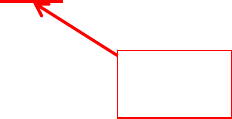
112
(21) Printer setting update
The following message is printed out. Press [MENU] (YES) button to update the printer
setup. Then the STATUS LED changes to light in red.
Do you update the printer setup?
YES(M) NO(F)
(22) Printing of the printer setup
The STATUS LED changes to light in green. Then following message is printed out. Press
[MENU] (YES) button to print the printer setup.
Do you print the printer setup?
YES(M) NO(F)
The following printer setup is printed out, then the printer is turned off. Make sure to
record the trailing 4 digit of [*BD address], because these 4 digits are used as pass
key to establish the Bluetooth communication between Smartphone and the printer.
(In the following example, “E874” is the pass key.)
PD-24 setup information
ROM Version :CP00-0701 2007-09-25
Boot version :CPBT-0002 2005-02-14
Firm version :CP00-07XX 2007-09-25
Font version :CP00XX01 2004-06-04
Interfce :Bluetooth & Cable Select
*BD address :00:01:90:E1:E8:74
・Printer setup
Paper setup Thermal paper
Ink volume ±0
Print pitch 10CPI
Character code set カタカナ
International Character Japan
Text O ff
QRsplit mode Mode 1
Edit speed Normal
・System setup
Power saving time 10 minutes
Link off Off
Marker detection function Off
Response control On
・Interface setup
Interface selection Bluetooth
Cable automatic detection On
Cable baud rate 9600
Cable data length 8Bit
Bluetooth
Pass key

113
Cable parity None
Cable stop bit 1Bit
Cable flow control XON/OFF
IrCZ baud rate 9600
IrCZ stop bit 1Bit
Bluetooth communication mode BOND
BONDlog deletion On
Bluetooth Inquriy Discoverable
Bluetoothpass key Default
End of menu
(23) Turn on the printer
Turn on the printer. After a while, the STATUS LED starts to blink in red, then the printer is
turned off automatically.
y After the printer setup above completed, you can print out the scan data to the
printer by Bluetooth-pairing Smartphone and the printer. If you want to connect
the printer to another Smartphone, you need to perform the printer setup
described in this section.
Caution
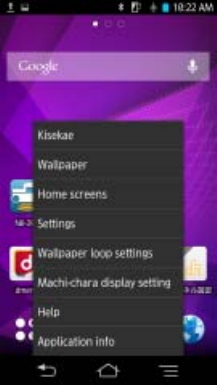
114
5.8.2. Bluetooth pairing
Smartphone communicates with the external printer by using Bluetooth communication.
For this Bluetooth communication, you need to turn the Bluetooth function of Smartphone
on and to execute the pairing of the Smartphone and the printer. For the details of the
procedure to pair Smartphone and the printer, refer to the manual attached to
Smartphone. An example of the pairing procedure is provided below.
(1) Turn on the printer.
(2) On Smartphone, tap [Settings] , then [Device settings]. Then the device settings
screen appears.
Figure 5-7 Device settings screen
)
)
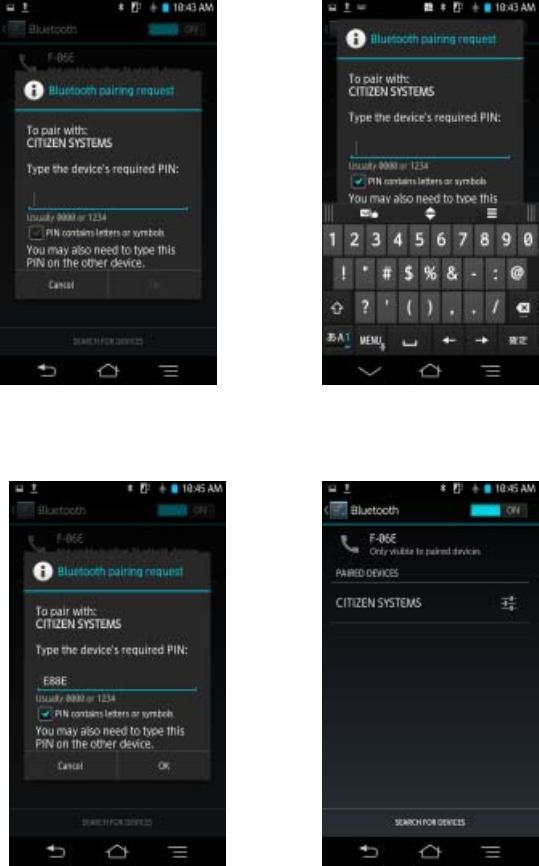
116
(5) In accordance with the instruction shown in Bluetooth pairing request screen, enter
the pass key recorded in 5.8.1 (22).
Figure 5-10 Pass key setup
(6) Tap [OK], then you can complete to paring Smartphone and the printer.
Figure 5-11 Pairing execution
(7) Tap [Home] button to return the home screen.
)
)
)
)
)
)
)
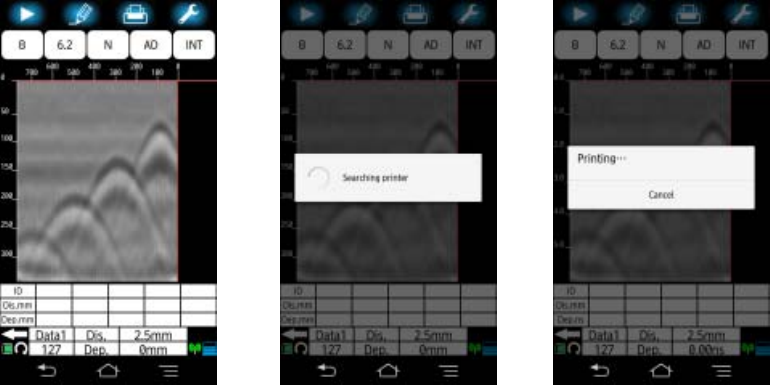
117
)
5.8.3. Printing scan data
You can print out the scan data by tapping[File/Print] icon. Before printing out, you need
to select the printer in [Save/Print ] menu accessed by long tapping [File/Print] icon.
(The shape of the [Save/Print] icon becomes a printer when the printer is selected.)
After tapping [File/Print] icon, NJJ-200 application searches the available printer and after
detecting a printer, it starts to print out. Then a message “Printing…” [Cancel] appears.
Here you can cancel the print out by tapping [Cancel] . After completing the print out, the
message disappears.
The printed scan data is from the scan image displayed on the main screen from the start
point of the scan data. When you want to print out all of the scan data, scroll the scan data
to the end of the scan data and then start the print out.
Figure 5-12 Scan data printing
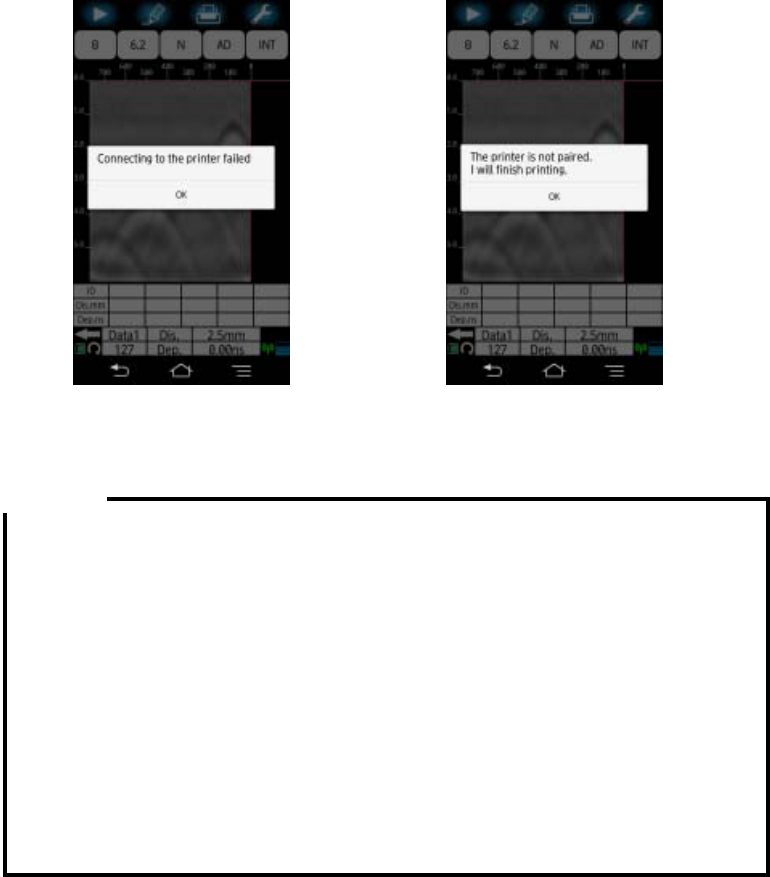
118
When the Smartphone cannot detect an available printer (ex. When the printer is not
turned on.), a message “Could not establish the communication with a printer.” [OK]
appears. In this case, confirm that the printer is turned on.
When Bluetooth pairing of the Smartphone and the printer is not completed, a message
“The printer is not paired. I will finish printing.” [OK] appears. In this case, shut down
NJJ-200 application and perform Bluetooth pairing in accordance with
Section 5.8.2 Bluetooth pairing.
1)Printer turned off 2)Bluetooth pairing not made
Figure 5-13 Example of printing failure
y Before printing out, the printer setup is required. Make sure to complete the printer
setup described in Section 5.8.1 Preparation for the printer.
y The printer is dedicated to NJJ-200 Handy Search. It is not applicable to the any
other Handy Search model.
y Make sure one Smartphone is paired to only one printer for Bluetooth pairing.
Smartphone does not allow you to select one from some available printers. The
scan data is printed out to the printer detected by Smartphone first of all.
y The print out is made in monochrome of 16 gradation). The printed image is not
the same as that of the scan image displayed on Smartphone.
y The print out of the scan data is compressed to fit for printing. Although the
position of the cursor and marker may be slightly moved on the print out, however,
the coordinate information of the cursor and marker is not changed.
y Make sure to use the recommended print paper.
Caution
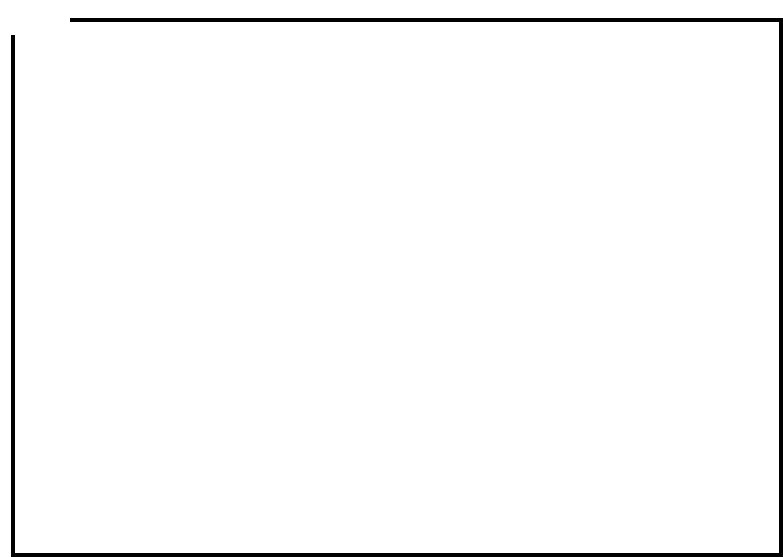
119
y For detailed information about the printer, refer to the printer manual. The range of
printing is from the scan start point (0 m) to the scan image displayed on the main
screen. To print out all the scan data, scroll the main screen to the end of the
scan position and print out the scan data.
y The direction of printing depends on the scan direction (forward or backward).
y The speed of printing slows down in accordance with the battery voltage of the
printer. Change the battery as soon as possible when the speed of printing out is
slowing down.
y When a message “Low printer battery voltage. “ [OK] during printing or at the
start of printing appears, it means that the battery voltage of the printer is dropping.
Turn off the printer and change the battery with a fully charged one.
y When a message “No print paper. Turn off the printer and supply the paper
to the printer.“ [OK] during printing or at the start of printing, the printer is in out of
paper. Turn off the printer and supply the print paper. (If the paper was supplied
when the printer is turned on, the next print out will not be executed correctly. In
this case, cancel the print out, and cycle the power of the printer.)
y For the scan data of the distance more than 10 m scanned with the distance
correction ≥ 13, when printing it in Wide (“W”) view range (Shallow W, Normal W,
Depth W), the printed image may be difficult to recognize.
Note
